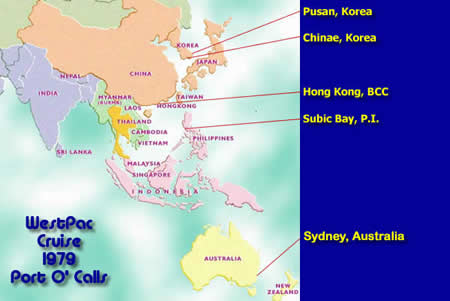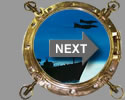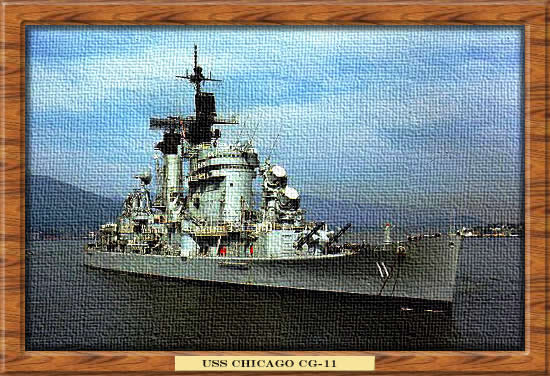
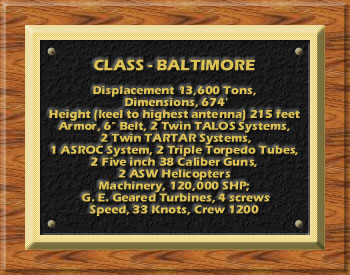
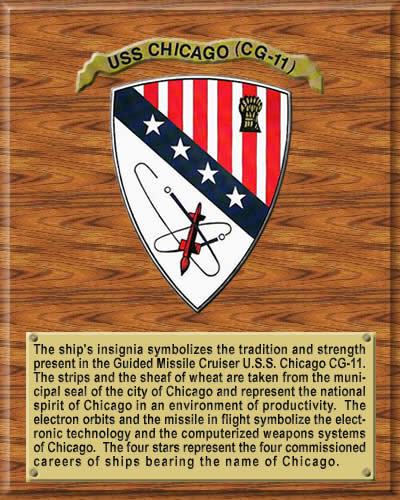
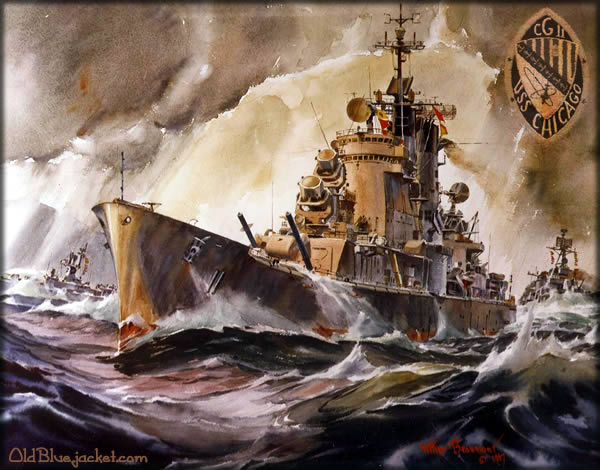
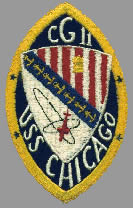
USS
Chicago (CG-11)
Homeport:
San Diego , CA
April 1977 - March 1980

I
moved
the family back to San Diego and we bought a townhouse in the
southern part of the city, near Chula Vista - we called the
area Chula-juana (we were only a mile or two from the mexican
border). Later on, after we got tired of chasing illegal aliens
out of our carport and yard, we sold the townhouse and moved
into Navy quarters in Pacific Beach. I reported aboard the USS
Chicago, at North Island Air Station, in April 1977. My job
would be Assistant Electronic Material Officer EMO. The
Chicago always had an excellent reputation and was billed as
the world's most powerful guided missile cruiser. With her twin
Talos (long range) and Tarter (short range) surface-to-air missile
launchers, dual triple tube torpedo launchers, twin 5'' gun
mounts, Anti-Submarine Rocket Launcher ASROC, and helo deck
made her a potent platform (winning 11 consecutive missile E's,
a Navy record).
In
1968, Chicago was successful in shooting down
a North Vietnamese Mig with a surface-to-air missile,
one of a small handful of ships to do so. Other ships
being USS Long Beach (the first ship to do so with a TALOS
missile - with two confirmed kills), and the USS Sterret
(with a Terrier missile). There may have been one or two other
ships, I've been told, that successfully scored kills with
surface-to-air missiles. The source of this info is GMCM
SK (Stan) Summers, who served on board the Chicago 1971 to
1974, as the LCPO of the TALOS Launching systems GMLS MK
12 Mod 1.
GMCM
Summers goes on to add: "Chicago fired
9 TALOS Missiles during the 1971/72 tour. The shore fire
was 50 to 60 rounds and they hit well aft of the ship, but
very close to our Destroyer Escorts. The ship almost went
dead in the water as all 4 of the TALOS system MG sets
were being energized at 1800 starting amps each. The ship
was in a hard turn to STBD, at I believe Flank Speed, which
was too much draw on the ship's generators. I ordered both
TALOS launching systems shut down and we did not lose the
load. I think we would have been in a world of deep doo doo
if the ship would have went dead in the water as we were
still with in range of the NVA shore battery!"
New
CO & XO. . . .
when
I reported aboard the Chicago, she was really in sad shape - she
was not the spit and polish, example of the cruiser Navy that
I had heard about or imagined. The current skipper (Capt. Beck)
had sacrificed over-all ship appearance and equipment preventative
maintenance to ensure the ship passed the Engineering Propulsion
Exam. The ship was a mess and the morale low, as non-engineering
departments were required to assign personnel to work down in
the engineering spaces - lagging pipe, chipping, painting, etc..
They worked long hot hours (in two 12 hr shifts, day and night
shifts), 6 days a week, and this went on for a little over a month.
Many of these personnel were third and second class petty officers
with technical ratings, who were usually exempt from such working
parties. They resented doing another shipmates job and wondered
how the engineering spaces got so bad to begin with. This created
a big problem later on in trying to get any of these individuals
to re-enlist - we lost a lot of good people due to this miserable
decision. I lost several ET's and FT's, one in particular, was
my division LPO, FTM1 Kincaid. He was an excellent LPO and well
liked by his men. He was extremely bitter over this ordeal and
after serving close to ten years, decided to leave the Navy. A
crying shame, as he would have made an excellent Chief.
This all changed when the dynamic duo arrived
-- Captain W. T. Piotti Jr. and Commander R. T. Reimann (another
vaporizer, but this guy was the champion) as the new CO and XO.
Later, both would go on to become Rear Admirals.
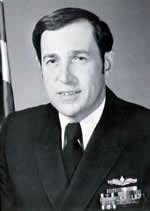
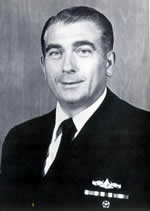
CO
- Capt. W.T. Piotti Jr. and XO - Cdr R.T. Reimann
Cdr
Reimann . . . .
Cdr
Reimann was coming from the job as O-in-C of Surface Warfare Officer
School Command Detachment in Coronado, Ca and brought the dubious
reputation as an executive ass-chewer (what I call a vaporizer).
Most junior officers on board were familiar with Cdr Reimann,
as they had attended SWO training under his cognizance - so the
stories/rumors were flying. I state later on that I did not agree
with his vaporizing management techniques, but I will say here
that to carry out this CO's plan of turning the Chicago back into
the show ship she was meant to be, he was probably the best man
for the job. He never passed the buck and he got the job done
- even at the expense of some good personnel (one of them was
my room mate).
Operations
Department took a lot of flack from Cdr Reimann as well, mainly
due to his personal dislike of Cdr Jackson (for whatever reason,
we never knew), the Operations Officer. Cdr Jackson took a lot
of verbal abuse from Reimann, but he buffered it well and never
passed it down.
Capt
Piotti . . . .
While
standing an afternoon quarterdeck watch during an open house (while
moored at Broadway Pier), I knew a major change was coming. Capt.
Piotti was aboard visiting the CO (Capt. Beck) and as he started
down the brow during his departure, he made the passing comment
"this ship looks like a sh** house." Upon assuming command,
Capt. Piotti, didn't waste any time turning the ship back into
the pride of the first fleet. It took a lot of chipping and painting
(many coats of haze gray, deck gray, and interior white - no more
black baseboards), brass shining and reshining, and replacement
of all interior deck tile with blue tile, but she looked great!
She was back being the show ship she had previously been! Only,
I believe Capt. Piotti took it a notch farther. The new motto
became "work
she will, shine she must!"
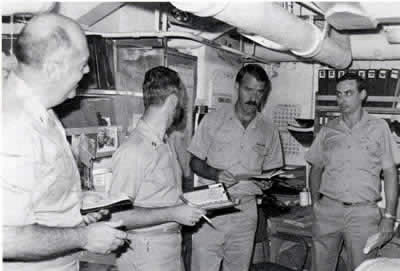
Morning
Quarters in the OPS office, with my boss (Ltjg O'Donnell) left,
Lt Bauman, Cdr Jackson (Ops boss) and myself.
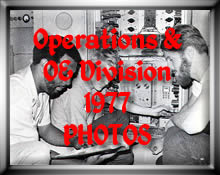
[Click On Button To View]
Assuming
additional duties as OE Division Officer. . . .
Soon
after arriving, I took over OE Division as Division Officer, in
addition to being the Assistant Electronic Material Officer. In
the capacity of OE Division Officer, I kept receiving complaints
from the troops about the toilets backing up in our compartment
head. It had been a continuing problem, even before I came aboard,
so I was bent on solving the problem. I jumped all over this LT
LDO engineering type telling him that this was a continuing problem
and it needed fixing ASAP. Well, I was sitting in my office one
day, and we had these dutch doors with just the top half swung
open. The DCA come walking up and leaned over the bottom part
of the door and placed this bucket on the floor and pulled the
top part of the door shut! He held that door shut to keep me from
getting out. The bucket had a big blob in the middle and was covered
with sewage from the CHT tanks (that the toilets drained into)
and did it ever stink!! He kept me in there for several minutes
before I started yelling "Uncle, Uncle" and some expletives!
It seems that one of my personnel had been flushing whole rolls
of toilet paper down the toilets (for whatever reason, I never
found out) and plugging up the whole system. I learned to check
out both sides of the story after that and not necessarily just
take the word of one of my troops. The DCA and I became good friends
after that.
When
I was the OE Division Officer (this job was later transferred to
a new Ensign in Ops - to gain experience as a division officer),
I took a genuine interest in the berthing spaces (cleanliness and
overall condition) and in their uniforms (especially prior to a
personnel inspection). Once the division is recognized (during material
inspections, XO berthing inspections, and personnel inspections)
as the best (or one of the best) division, it takes little motivation
after that - they will usually police themselves. During my first
personnel inspection on board, I made each individual lay out their
inspection uniform, so my head chief and I could inspect it. After
correcting all their discrepancies, we took Best Division at the
official inspection. Their reward was not having to participate
in the next inspection. In addition, our berthing spaces were always
recognized as one of the best on the ship.
Civilian
Combat Systems Rep. . . .
The
Chicago, was organized in accordance with the new Combat Systems
philosophy. Being organized so, I was additionally responsible for
the maintenance on the AN/SPS-48C Radar which put 6-8 FT's under
my cognizance. Since this philosophy was relatively new and the
Chicago had so much electronic equipment, a civilian contractor
maintenance technician was attached to the ship and was under the
cognizance of the EMO. This contractor was not utilized much when
I first reported aboard - he mostly just laid around his stateroom
and read pocketbooks. Well, I thought this was a total waste of
the Navy's money, so I decided to put this guy to work. After hearing
of an equipment casualty with the 48 radar (and since this radar
was supposed to be his specialty), I sent this contractor up to
the 48 room to assist the FT's in troubleshooting the problem. A
little while later, my leading FT1 comes bursting into the EMO office
and says "get that guy out of my radar space, before I kill
him!" Well, that didn't work, so I sent him up to the communications
shop to help them out. They put him on a relatively easy job of
troubleshooting an R-390 HF Receiver. The R-390 is a fairly easy
radio to troubleshoot, as long as you don't mess with the front
panel gear train (more complicated than an automobile transmission).
Well, that was what this guy diagnosed as the problem (which it
wasn't) and completely disassembled the whole gear train! Well,
my leading communications tech made the same threat as the FT1,
so I jerked him out of that space and sent him back to his room.
I eventually, over a period of two quarters was able to lower his
evaluation marks sufficiently low enough to get him pulled from
the ship - we also convinced the Navy that we didn't need civilian
reps on board.
Equipment
Status Board
. . . .
In
the Electronic Material Office, there was a equipment repair status
board mounted on the bulkhead which listed all equipment casualties.
When I first came aboard, this board had anywhere from 20-25 pieces
of equipment listed (requiring various types of repair) at any one
given time. Two thirds, or more, were usually CASREP'd. It seemed
to be the norm for this amount of equipment. I also had three E-7's
and an E-8, for maintenance chiefs. I wasn't impressed with two
of the senior E-7's and the E-8 was a short timer. I made one the
Department 3-M Coordinator and pretty much fired the rest - except
the junior E-7. The junior E-7 had been billeted in Navy special
type programs for several years and volunteered for sea duty to
get back into his rate (in order to make E-8). I ended up giving
him the whole ball of wax and he did an excellent job for me - made
E-8 too. Between the two of us, we whittled that repair list down
to an average of just 5-6 pieces under repair or CASREP'd at any
given time.
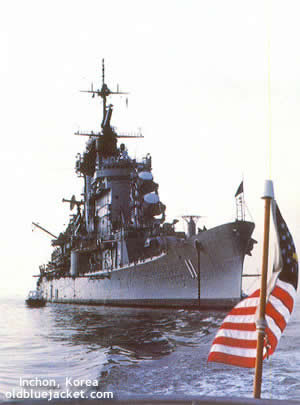
View
Of The Mighty Chi (From Liberty Boat) Anchored In Inchon, Korea
WestPac
Deployment, 1977 . . . .
In
September we embarked on a 6 month WestPac cruise with ports-o-calls
in Pearl Harbor HI, Subic Bay PI, Hong Kong BCC.(two times), Keelung
Taiwan, Pattaya Beach Thailand, Inchon Korea, Manila PI, Yokosuka
Japan, Singapore and Guam. We were not assigned to a carrier battle
group, so it was all independent steaming. One of the best WestPacs
I was ever on, almost more liberty ports than we had money for.
One USO tour to the demilitarized zone and the peace village Panmunjom
was especially memorable. It really opens your eyes about the mentality
of the North Koreans.
HHHere
are a few photos taken at the demilitarized zone at Panmunjom.
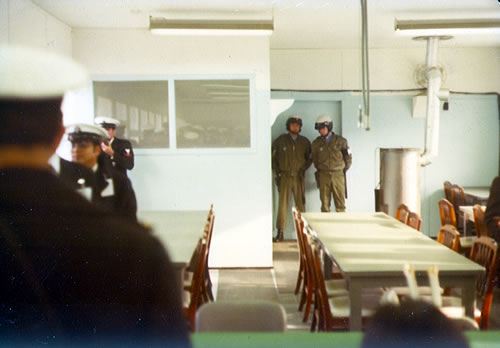
This
is the room where all the negotiations with North Korea take
place. Half the room is on the South Korea side and half on
the North Korea side. The border runs right down the center
of the green table in the foreground - I'm actually standing
on the North Korea side when taking this photo.
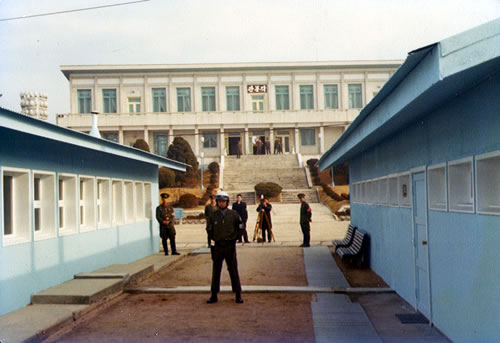
The Korean border is the cement line
on the ground just behind
the friendly border guard in the foreground. The guards in the
background are North Koreans who were filming our tour group
for some unknown reason. The 2-story building in the far back-
ground is a facade, it is only about 10-15 feet deep, it was built
for show and propaganda purposes.
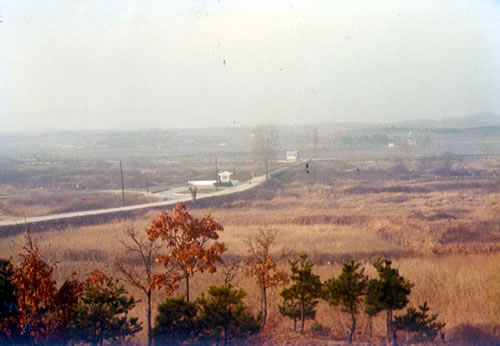
Site
of the
1976 poplar tree incident - -
Two US soldiers,
sent to clear a tree that obstructed
the view in the
Panmunjom
truce zone (the tree to the right of the check point station), were
hacked to death by a North Korean soldier.
When
arriving in Hong Kong, the ship (like all U.S. Navy ships) was met
by Mary Soo and her slew of workers. For anyone unaware of who Mary
Soo is, her family and workers would greet each ship in their small
sampans. During our port visit, they would paint out the whole exterior
of the ship, down to the waterline - the ship would provide the
paint. They used only wadded up rags to accomplish this task. For
this, they would take our food scraps by scraping all the plates
(into a big bucket) at the end of our chow lines, hauling away our
garbage, and taking any scrap metal offered (particularly brass).
Mary Soo then re-distributes this to the poor and sells the bent
nails, broken wooden crates and scrap brass she receives to pay
the small wages of her painters. My roommate happened to be the
ship's Boats'n (another CWO2) and he was invited, along with his
chief Boatswain, to a dinner provided by Mary Soo to thank the ship.
The chief couldn't make it, so the Boats'n asked me if I wanted
to go - I said okay, since I didn't have anything else to do. We
were picked up at fleet landing by a limo and chauffeured somewhere
up into the back hills of Hong Kong. We arrived at this real nice
restaurant and were greeted by an English speaking Chinese. He asked
us what we liked to drink, the Boats'n, being a Mormon, asked for
a coke or something. I said "how about scotch?", and he
handed me a whole new bottle of Johnny Walker Black and said keep
it! There were close to a hundred Chinese or so in attendance and
only us two Americans. They were participating in several type of
gambling games, we declined to join them and just watched - a couple
fights almost broke out too from some heavy gambling losses. Then,
we sat down for the big meal and what a meal it was. It was undoubtedly
the best Chinese food I have ever eaten and it just kept coming
and coming. I didn't ask what I was eating, I just ate it and I
was totally stuffed!
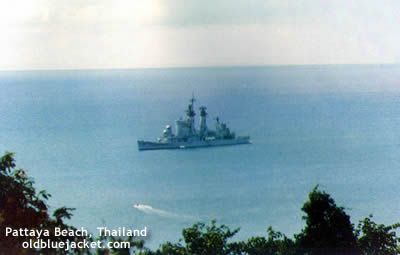
The
Mighty Chi Anchored Out In Pattaya Beach, Thailand
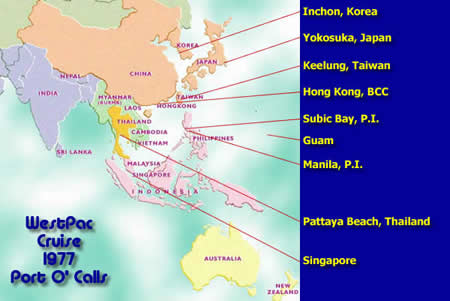
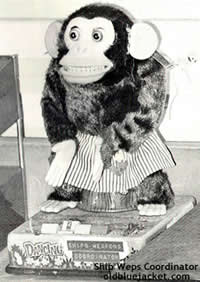
OPS Monkey
Operations
Monkey . . . .
During
this cruise, one of the Ops Officers bought a small mechanical monkey
and kept it on his desk in the Ops Office. It was officially labeled
"Ship's Weapons Coordinator." This monkey would do several
different jigs or dances (ending with a big grin on its face), the
speed and rhythm dependent upon which button (total of four selections)
one pushed. This monkey became quite the morale gauge of one's mood,
a slower selection if you're in a good mood or fast selection for
a bad day. Also, if a lecture/meeting was in place, that had a dry
or boring spot or two, someone would inadvertently (and stealthily)
hit one of the buttons - this usually got a rise out of everyone.
We had a lot of fun with that monkey.
Creamed
by the pollywogs . . . .
On the way to Singapore, where we spent Christmas,
we crossed over the equator and initiated the pollywogs on board.
The day before the pollywogs are initiated, it is their day to play
tricks on the shell backs. I told my boss that I wasn't going to
be had and that I would be doing paperwork in my room most of the
day. That was a mistake, trusting him, as he was a pollywog too.
One of the men (I just learned recently that it was ETR3 Fetters)
concocted a story about the SPS-43 air search radar going down and
asked my boss to have me check into it. I was suspicious, but I
cautiously proceeded to the radar room watching for the pollywogs
on the way. When I reached the radar room, I cautiously peered in
before entering, and when it looked secure I proceeded into the
room. I never knew so many men could hide in an overhead and each
had a full can of shaving cream! When I left the room, I was one
big blob of shaving cream, from head to toe! Walking back to my
room, the XO (Reimann) peered out his door, took one look at me
and I said "don't ask, XO." As I walked away I could hear
him laughing hysterically in his room.
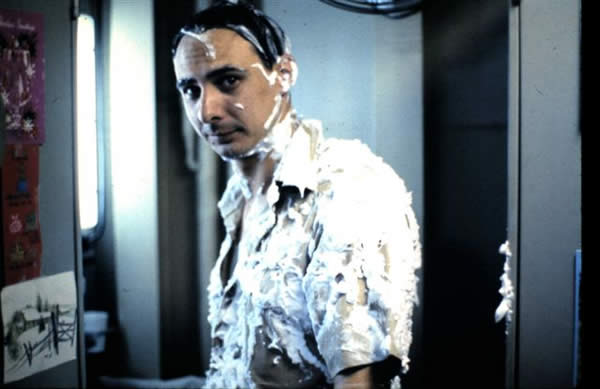
Attack of the WOGs
Room
mate . . . .
My
room mate was the ship's Boats'n, CWO2 Olson. His job was probably
the worst job on the ship, under the Piotti/Reimann regime. Fortunately,
he didn't move his family out to San Diego (left them in Utah),
because he wouldn't have seen them much. This man took relentless
ass chewing's from Reimann, on a daily basis due to the almost impossible
task of keeping this ship's massive exterior in pristine condition.
Boats'n Olson was a good man and didn't deserve the abuse that Reimann
relentlessly dished out to him. This abuse eventually caused him
to retire early.
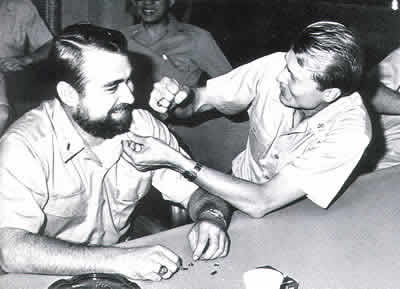
Boats'n Olson tacks on LtJg Parker's
new silver bars
Not
easy to room with . . . .
I
wasn't the easiest guy to room with, because of the demand of my
job to be available 24-7. At sea, my phone would ring several times
during the night with equipment status and casualty reports from
the aft ET Shop watch personnel. I was required to be aware of all
equipment casualties and I would then have to relay this status,
if necessary to my boss. Because of this demand, I wasn't required
to stand underway watches.
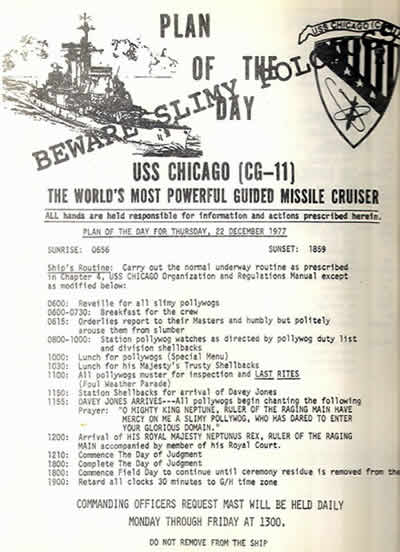
Crossing
The Equator Ceremony
POD
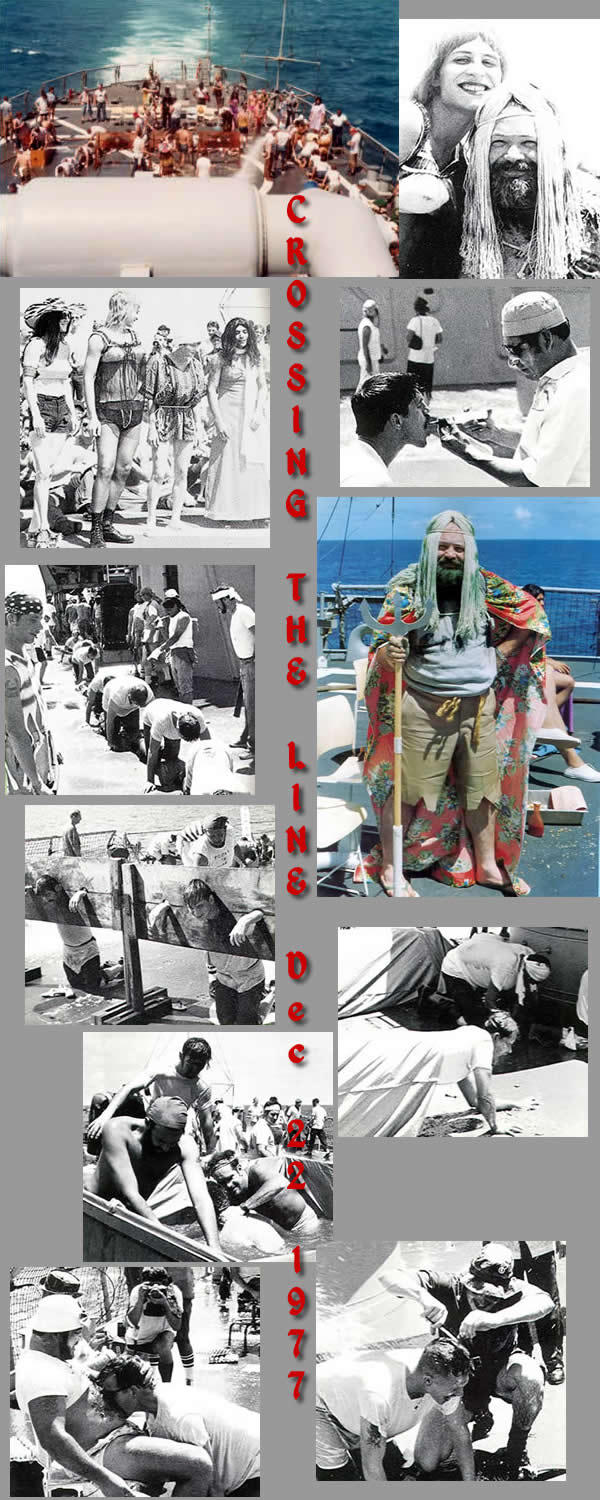
Training
junior officers. . . .
Soon
after arriving on board, I was taken aside and indoctrinated,
by my LT (LDO) boss, into some of the unofficial job requirements
of a Warrant Officer. One of these unofficial requirements was
to take new Ensigns and LTJG's under one's arm and help them
in learning the Navy life. In other words, jump in their face
when they need a little personal guidance. Here are a couple
of those interactions that I can recall:
1.
I was eating lunch in the wardroom one day, while underway,
when this one junior officer jumped all over several mess stewards,
chewing them out over some trivial matter. Then, he ordered
one to bring him a cup of coffee. A little while later, the
mess steward returned with his coffee. I waited after he took
a couple sips and then said "does your coffee taste a little
different, Ensign?" He gave me a funny look and then immediately
got up from the table and took off! Everyone had a good laugh
after he left. I will almost guarantee you that if you piss
off a mess steward, he will get even!
2.
On one particular day in port, the word was put out at morning
quarters that haircuts were required of everyone who needed
one - prior to going on liberty that evening. Well, I had the
1600 - 2000 watch on the forward brow when an Ensign, who was
in badly need of a haircut, tried to leave the ship. I stopped
him and reminded him of the word about getting a haircut if
you needed one - and that meant officers too! I then informed
him that he wasn't going off my brow until he got a haircut.
He eventually left the ship, but it was after I got relieved
at the end of my watch.
3.
This story is from SHCM Lou Garza (the leading Ship Serviceman
on board): "One day while tied
up at NAS North Island on a duty day. Gunner Kriner and I were
in the same duty section. I was standing by the rail when I
saw Ens Sabalos coming back from what turned out to be a trip
to the Base Exchange. Gunner Kriner had the quarterdeck OOD
watch. As Ens Sabalos came onboard, I saw the Gunner talking
to him. After the Gunner was done with him, the Ens came up
to me and asked "who is that guy?" I told him who
it was and then he asked, "I'm senior to him, right"?
And I said "yes, sir you sure are". Then I asked him
"why". And he says "he just gave me a bunch of
sh** about being off the ship while on duty. I think I'll write
him up." I could hardly keep from laughing, but I said
"yes, sir, I would, you can't let those warrants get away
with stuff like that." Don't know what happened, but I
can imagine what Reimann did to him!"
4.
Another Ens Sablos story from SHCM Garza: "One
Sunday while underway to WestPac - A holiday routine type Sunday.
I came into the CPO goat locker for brunch. After brunch, having
my second cup of joe, I'm watching close circuit TV where they're
showing a Robert Schuller Sunday Services program. They are
singing hymns with the words showing on the screen so you can
sing along with the program. Trouble was, the screen was misaligned
and you could only read half the words. I decided what I could
do to remedy the situation. I picked up the phone and dialed
the projection room number. As luck would have it, Ens Sabalos
answers the phone. I asked "hey, how do you expect us to
sing the hymns if we can't read the words on the screen?"
The Ensign replied " I'm sorry sir, but this is old equipment
and that's the best you're going to get." I said "never
mind, I'll just call the Chaplain" and slammed the phone
down. Within a few seconds, the picture lined up perfectly on
the screen. Everybody in the mess roared when they found out
who I had been talking to."
We
had our own Warrant Officer table in the wardroom mess (until
Reimann eliminated it) and on each evening underway, a junior
officer was assigned to dine at our table as part of broadening
their educational experience. Most of them hated it because
we had a lot of fun terrorizing many of them! Now, if the officer
had been an ex-enlisted type, we usually left them pretty much
alone. These types were a little more seasoned and could just
about handle anything we threw at them anyway.
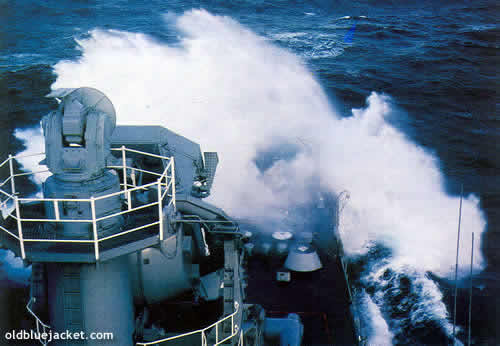
Steaming through some rough
water in the South China Seas.
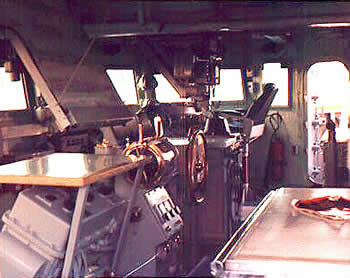
USS Chicago Bridge.
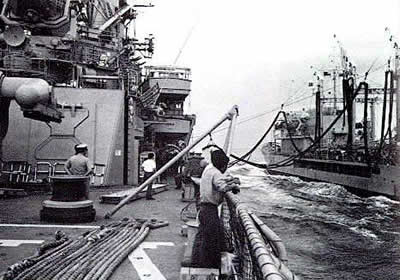
Chicago Refueling At Sea.
The
dice . . . .
I
remember
another funny incident that occurred while I was the OOD on the
quarterdeck. It was while we were moored in Subic Bay. There was
a requirement, for enlisted personnel below E-6, when coming back
aboard ship (even if they were only dumping the trash) to go through
a random drug search. The random criteria was determined by rolling
a single dice, and if the number determined by the Master-of-Arms
was rolled, he got searched. We were well into the last hour of
this particular watch and no one had rolled the picked number
- ergo, no one had been searched through this 4-hr watch. I thought
the odds of this happening was pretty high, so I picked up the
die and rolled it around in my fingers analyzing it. I said to
the duty Master-at-Arms "do you want to know why no one has
rolled a 2 (or whatever the picked number was)?" He says
"no, why?" I said "that's because there is no 2
on this die!" Someone had pulled a switch on us and neither
of us noticed it. He didn't think it was very funny, but I sure
laughed.
To
add to this dice story, I recently received an email from one
of the ET's in my division - ETR3 Gary Fetters. He states "it
was an OE inside job and it all started with Craig McElwain and
myself bitching about rolling dice to gain entrance to the ship,
we both thought it disrespectful that 2nd and 3rd class petty
officers had to go thru such humiliation. I don`t know who came
up with the idea first, but I think the number that won a sailor
a strip search at the beginning was a two. One of us joked that
changing the two to a three would be easy to accomplish, and since
ET's manned the brow watch we could easily make the switch. We
enlisted Donny Anderson and Steve Miller and went into one of
our work spaces and practiced indenting dice, our first attempts
failed, using a power drill caused the indent to be too deep,
finally after ruining a few dice we figured we could put a very
sharp drill bit between fingers on two hands and while using a
rubbing motion (hand against hand) we could slowly drill a indent
into the dice that looked perfect, next was dabbing some white
paint with a cue tip and waiting for it to dry. I remember laughing
until I was teary eyed. When we got it perfect, the switch was
the easy part. Donny had duty that evening and I forget now if
he just switched the dice or if Steve or Craig palmed the good
one and tossed the bad one when returning from liberty, I think
it was the later. We didn't want to implicate Donny but needed
him to look the other way when the switch was made. It was a great
secret not shared with many of our shipmates, we knew this could
get us into big trouble so it was a silent joke shared by only
a few. I think the rigged dice remained undiscovered for 3 or
more watch cycles, nearly 24 hours. We knew if we managed to make
the switch we would never be caught, anyone could have done this
and all four of us were salty veterans and unafraid of authority.
The idea that we may have helped some of the lower class types
to smuggle drugs on board didn't cross our minds, our intent was
not to help them, none of us used drugs (our drug of choice was
San Miguel, by the gallons) we just wanted to send a message to
the brown hats that they were not completely in charge".
I
had no idea that any of my people were behind this trick, but
I sure thought it was funny at the time. Leave it to a few ingenious
smarter-than-average sailors to come up with an idea like that.
Gary Fetters also confessed to me that he was the one behind the
idea to sucker me into the SPS-43 Radar Room, which resulted in
me being saturated with shaving cream! All I can say is "well
done sailor, you sure got me good!"
My
new boss arrives onboard . . . .
It
was just prior to our arrival in Inchon, Korea (I believe) that
my new boss, LtJg O'Donnell (promoted to LT soon after arrival),
arrived on board. We hit it off right from the start. He had come
from serving in several shore (overseas) admin billets and was
not up to speed on electronic equipment maintenance, so we came
to an immediate agreement that he would handle the admin side
and I would handle the maintenance side. This relationship worked
great, and working in unison with my leading Chief (ETCS Coates),
we whittled down the CASREP/Down Equipment List to a manageable
level - the lowest it had ever been. Lt O'Donnell was an excellent
officer to work for and a very close friend to this day.
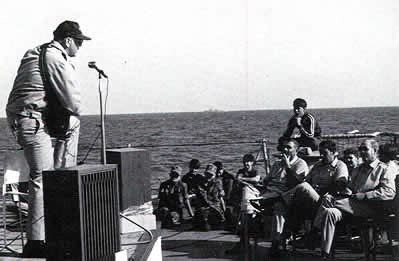
Lt O'Donnell (my boss) singing
an Irish Ditty during onboard
talent contest while at sea.
Stories
about Bunky . . . .
No
story about the Chicago is complete unless you mention an individual
by the name of "Bunky." He was an FT3, I believe. The
first story was handed down to me from a good friend whom had
served as the NTDS Maintenance Officer prior to my arrival on
board (we were also fellow instructors at ETB school). Bunky was
working on a fire control console down in CIC (CIC was located
below the main deck on the Chicago) and he had not finished repairing
it by the time CIC was being manned for an exercise. The Ops boss
(CDR Gillette) asks Bunky "when will this console be fixed?"
Bunky replies, in a slow hillbilly drawl, "now I don't rightly
know, it might take me 15-minutes or it might take me 2-hours."
I guess the CDR had to immediately walk away before he blew his
top. So, this LT comes over and asks Bunky "when will the
console be repaired?" Bunky says "like I told that other
feller over there, it might take me 15-minutes or it might take
me 2-hours!" By then, just about everyone was rolling on
the decks!
Another
story about Bunky happened to me. I was the OOD on the quarterdeck,
just prior to Capt. Piotti's change-of-command (he was relieved
by Capt. H. Lewis), while we were undergoing overhaul in the shipyards
in Long Beach. On this day an Admiral was scheduled to come aboard,
at any time, to visit the Captain. Needless to say, the quarterdeck
was shining and all the ceremonial passageways were to remain
clear - all the normal preparations for the arrival of an Admiral
on the Chicago. Everything was going along fine, while we were
waiting for this Admiral's arrival. All of a sudden, one of my
watch standers gasped and I turned around just in time to see
Bunky heading down the brow with a big plastic bag that was leaking
some kind of oil! Then, I saw this trail of oil back through one
of the hatches and down the passageways! Well, I figured my Navy
career was over right there! As it turned out, I was able to get
a bunch of bodies ASAP to help get it all cleaned up, just prior
to the Admiral's arrival. The best part was the XO and CO never
found out. I think I sprouted a couple gray hairs though!
Another
Bunky story was relayed to me recently from ETR3 Gary Fetters.
Bunky had his molars removed one day
on board the ship, we were deep into the 77 West Pac, and all
of us ETs were in the “coop” watching television when
he walked in. His cheeks were swollen and both eyes were blacked,
he looked like a raccoon that had been hit by a truck, we all
laughed and teased him, he got pissed and in a drawl that dripped
of deep southern Cajun, he hollered at us all as he left the space
“f**k all yahawwll.” I can still hear him clearly
and the laughter still makes my eyes leak.
Another
Cdr Gillette story . . . .
Another
story, which happened while that same old ETB School friend of
mine was serving on the Chicago as NTDS Maintenance Officer, occurred
during another exercise manning and it too involved CDR Gillette.
One of his NTDS maintenance tech's, added a small software routine
to the main NTDS software program and had forgot to remove it.
When CDR Gillette sat down at his NTDS console, this monster (made
up of several NTDS symbols) moves across the display and then
eats the "ownship" symbol in the center of the display
and then strolls off the screen! I guess the CDR just about fell
out of his chair!
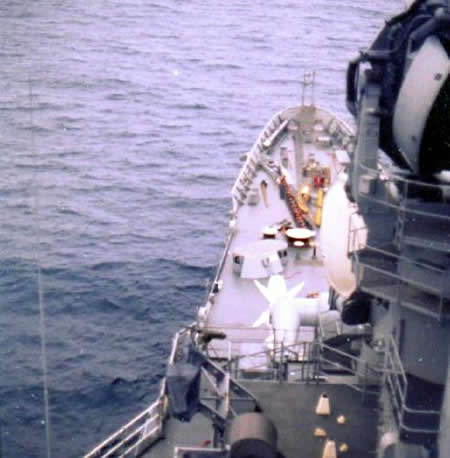
Talos
Missile On The Rail - Forward Launcher
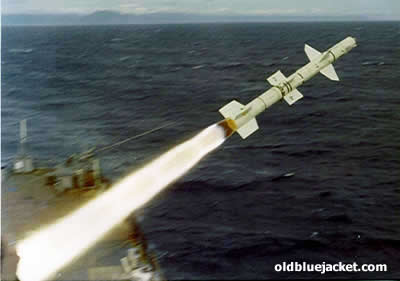
Talos
Missile Launch - Aft Launcher
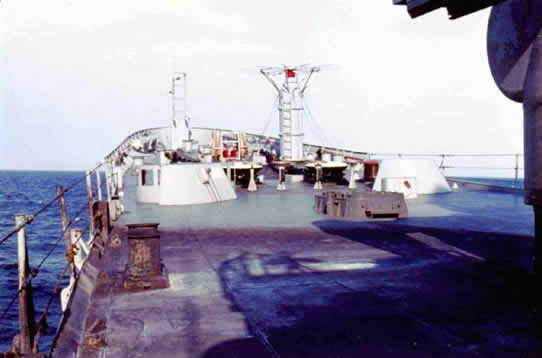
And,
what the deck looks like after launching one of these suckers .
. . .
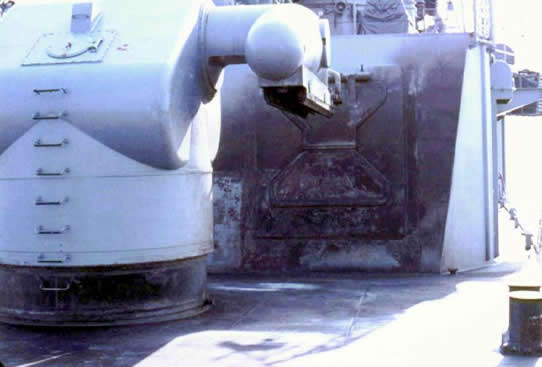
Tiger
Cruise, 1978 . . . .
We
returned to the states in mid April 1978. On the way back and during
an overnight stop in Pearl Harbor, the Tigers arrived on board.
Tigers are male dependents, over the age of ten, who are allowed
to ride the ship on the five day run back to San Diego. My son was
among them. He rode the ship back to San Diego with me. He became
attached to the Marines in the Marine detachment. One evening I
became worried about his whereabouts and went looking for him. I
found him standing in line at the soda fountain. It seems the Marines
were paying him to stand in line for them. The Marines let him shoot
their rifles and machine guns over the side, and he's been hooked
on the Marines ever since (becoming one later himself). The ship
put on a great show for the Tigers, all part of Reimann's showmanship
routine.
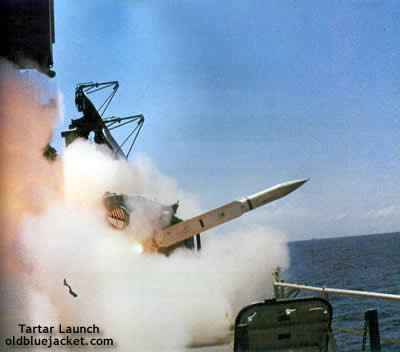
Tartar
Missile Launch - Port Launcher
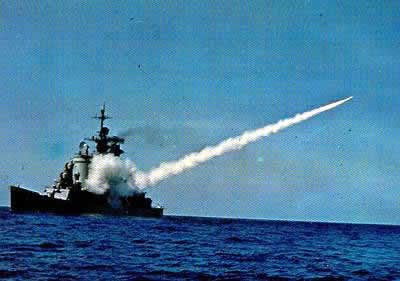
Removal
of the Bridge Radar Repeaters . . . .
The
passageways, and hatch openings, from the quarterdeck to an area
dubbed "Hollywood and Vine," was called the ceremonial
passageways and placed off-limits to most personnel. The ship, having
11-levels of superstructure, also had an elevator to the 08 level
(bridge) that was restricted to 05 (Commander) and above. Why do
I mention all this? The ship was scheduled for an extended shipyard
overhaul period in Long Beach, CA. Prior to our departure, my head
Chief and I arranged with SIMA (Ship's Intermediate Maintenance
Activity) in San Diego to leave behind numerous radar repeaters.
These were to be overhauled and worked on by our own technicians,
as a reward to the hardest workers - they were able to remain with
their families in San Diego. We had two radar repeaters on the bridge
that required overhaul and required removal and transportation to
SIMA. The ship was moored at Pier Juliet, North Island at the time.
Since Pier Juliet was essentially a condemned pier at the time,
no cranes were allowed on the pier. So, the only remaining method
of removing the repeaters was good old manpower. We waited until
late into the evening, when the CO, XO and all senior officers were
gone for the day and proceeded to remove the repeaters. We placed
look-outs strategically along the route we were going to use. We
manually lifted the repeaters onto dollies, rolled them into the
senior officer's elevator, rode the elevator down to Hollywood and
Vine, and rolled the repeaters through the ceremonial passageways,
stopping to lift them through hatch openings, and right off the
quarterdeck and down the brow before they knew what happened! I
had one person with a small can of white paint and a paint brush
following behind, painting all the nicks and gouges we left in the
hatch openings. Just when we thought we were in the clear, a little
later the CO returned to the ship - and he very seldom ever does
this in port stateside! On his way to his cabin, through the ceremonial
passageways, he inadvertently touched one of our paint touch-up
spots and got wet paint on his hand. The CDO (Command Duty Officer)
was following along and the CO says "why is there wet paint
on these hatch openings?" The CDO (a jerk) blurts out "oh
that's from Willis and his group removing radar repeaters off the
ship." As you might expect, he got his butt reamed royally
and I heard about it the next day. The next day, the OPs boss says
to me "nice move Willis!" I said "hey, I got them
off the ship didn't I?" No one would ever had known if the
skipper hadn't returned before the paint had a chance to dry!
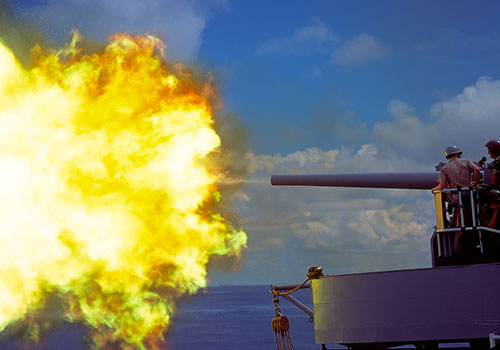
5-Inch
Gun - Starboard Mount - Photo courtesy of Bernard Lynch.
If you would like a print, click on the photo.
Capt.
W.T. Piotti . . . .
Captain
Piotti, along with Commander R. Wolfe (CO of USS L. Mendel 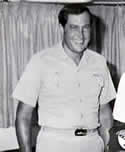 Rivers
SSN-686), were two of the best skippers I had the pleasure to serve
under. In an actual combat/wartime situation, I would want to be
serving under one of these men. They were brilliant tacticians,
expert ship handlers, and excellent leaders. They knew how to command,
they knew how to get the best and most out of their men. While underway
at sea, on the Chicago, Captain Piotti required a different junior
officer to dine with him in his cabin at each evening meal. I had
the opportunity to dine with him on two different occasions. Looking
back, what really sticks out in my mind was his genuine interest
in you. I remember him asking me "how does a Ship's Serviceman
Barber become a Electronics Technician Warrant Officer?" That
told me he read both my enlisted and officer personnel record. I
later learned that he read every officer's (and Chief's) service
jacket and knew everything about you. He really took an interest
in all his men - a total reversal of the philosophy of the last
skipper I would serve under several years later. He went on to become
CruDesGroup Five, CTF 71 (Commander of the search and rescue/salvage
of KAL Flight 007, which was shot down by the Soviets), and the
last I heard he was Commander of the Military Sea Lift Command. Rivers
SSN-686), were two of the best skippers I had the pleasure to serve
under. In an actual combat/wartime situation, I would want to be
serving under one of these men. They were brilliant tacticians,
expert ship handlers, and excellent leaders. They knew how to command,
they knew how to get the best and most out of their men. While underway
at sea, on the Chicago, Captain Piotti required a different junior
officer to dine with him in his cabin at each evening meal. I had
the opportunity to dine with him on two different occasions. Looking
back, what really sticks out in my mind was his genuine interest
in you. I remember him asking me "how does a Ship's Serviceman
Barber become a Electronics Technician Warrant Officer?" That
told me he read both my enlisted and officer personnel record. I
later learned that he read every officer's (and Chief's) service
jacket and knew everything about you. He really took an interest
in all his men - a total reversal of the philosophy of the last
skipper I would serve under several years later. He went on to become
CruDesGroup Five, CTF 71 (Commander of the search and rescue/salvage
of KAL Flight 007, which was shot down by the Soviets), and the
last I heard he was Commander of the Military Sea Lift Command.
I
remember when I was called as a witness to Captains Mast.
On our last night in port in Yokosuka, Japan, and a payday
night no less, many crew members decided to dismantle several local
business establishments in town. I had shore patrol that night and
spent most the night chasing down several of these sailors. At this
CO mast, one of these sailors was brought before the Captain. This
particular sailor had been one we had apprehended after destroying
the back bar in a bar. We chased him down and took him back to the
bar, in which he was identified as the guilty party. Of course,
at CO mast he denies doing it, and for the life of me I don't understand
why, but his division Chief protects him by making up a story placing
him somewhere else. The CO asked me if I was sure he was the man
that committed the offense and I said "yes." The CO took
my word and hung the young man. I always respected him for that.
One
of my worst job pressure situations occurred while in WestPac (1979
cruise) and Piotti was Chief of Staff for CTF-75, I believe. I had
to write my first (and last) C-4 CASREP, because all three of my
air search radars were down. The SPS-48 had a chunk ripped out of
the antenna (after snagging the Admiral's flag halyard), the ancient
SPS-30 was down due to multiple problems, and The SPS-43 went down
with a bad rotary joint or bandpass filter. Because of these causalities,
we had to return to Subic Bay for emergency repairs. Capt. Piotti
was sitting in the O'Club in Subic and saw the Chicago arrive. He
made note of it by making comments to the current skipper about
being unable to meet our mission. It was not exactly a career enhancing
situation, believe me. We finally repaired the SPS-43 (and the SPS-30
a little later) and I remember ruining a pair of Khaki's climbing
the mast in search of hot spots on the Bandpass Filter.
Fortunately, this filter proved to be the defective component.
Throughout
Capt. Piotti's tenure, we were not allowed to wear a piss-cutter
(aka garrison cap, or fore&aft cap) anywhere on or off the ship.
I never thought too much about the rule at the time, as I had never
worn one before anyway. I don't remember when it was, after Capt.
Piotti's departure or at my next duty station, but I decided to
wear my piss-cutter one day. After donning the cap, I took one look
in the mirror and said to myself "that has to be one of the
stupidest looking caps I've ever seen on a sailor!" I immediately
took it off and never put it on again. I then knew why Capt. Piotti
disliked that hat.
Cdr
R.T. Reimann . . . .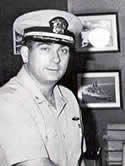
The
XO (CDR Reimann - later a Captain and Admiral himself) was something
different. Even though his "showmanship and seven P's"
philosophy was extremely effective (something
I learned the hard way later, in a bad decision I made that
was contrary to this philosophy), I never liked
his screaming and hollering techniques. I realize that he was
just following orders in most situations, but chastising/vaporizing
a man (especially in front of his men) for every little wrong
just shows your limited management ability, in my opinion. Like
many of us, after awhile it just goes in one ear and out the
other. The
following incidents are a sampling of some Reimann stories:
- While standing duty in-port as OOD (Officer-Of-The-Deck) on
the Quarterdeck, my Boatswain of the watch screwed up the amount
of bells when announcing the CO's departure. The deed was already
done and he knew he had screwed up and I just looked at him,
pointed at the phone, and said "you get to answer the phone!"
Just as I pointed at the phone, it rang, and it was the XO.
He was screaming so loud that you could have placed the phone
receiver on the pier and still hear him! I guess that wasn't
enough, because he came screaming out onto the quarterdeck and
commenced to give us a demonstration on the proper way to ring
the Ship's Bell (with our heads a few inches away) and then
commenced to chew me up one side and down the other in a voice
so loud, that you could hear him halfway across the base. I
guess I gave him the "are you done yet" look, because
I ended up standing an extra 4-hour watch.
- Another example of his vaporizing (or super ass chewing) technique
occurred when one of the Engineering LDO type's wife was sending
her husband a singing telegram. The individual delivering the
telegram was running late, so the only strategy the XO could
think of to keep the officer in the wardroom (until this individual
arrived) was to start chewing on him. The poor guy had to sit
there and endure this abuse until the telegram arrived. Afterwards,
the XO thought it was real funny and joked about it. I don't
think the officer thought it was funny at all - they divorced
a few months later.
- Then, there is the infamous Rackzo story, which occurred during
an abandon ship drill. All hands were hastily assembling in
their assigned areas - designated as a specific Rack Number
(Rack 1, Rack 2, etc,). Once assembled, a muster report is dispatched
from each Rack assembly area to the bridge. After these muster
reports (depicting any missing personnel) were dispatched to
the bridge, we hear over the 1MC "Fireman Rackzo report
to the bridge." This announcement came a few more times
and when Fireman Rackzo failed to arrive, the XO started yelling
for "Fireman Rackzo, report to the bridge immediately!"
His yelling continued and was so loud (and he wasn't using the
1MC), we could hear him all the way back to the fantail. Finally,
someone whispered in his ear that he was reading Rack 20 as
Rackzo and since Rack 20 came after Rack 19 (an Engineering
Rack), he assumed it was a Fireman Rackzo. There was no missing
personnel after all. It was very difficult trying to eat the
evening meal in the wardroom that night, as we were all trying
our best not to split a gut and hold our laughter in. The XO
didn't think it was very funny at all.
- One funny story, I remember, is about a christmas tree in
the wardroom. The XO tasked one of the junior Ensigns with the
task of trimming and decorating a christmas tree for the wardroom.
To fit the tree in the wardroom, the tree needed to be trimmed
down a couple feet. I remember walking into the wardroom, right
past the new tree, and suddenly, something didn't seem just
right and I stopped in my tracks. I looked at the tree and the
top was missing! The Ensign cut two feet off the top of the
tree instead of the bottom! While several other officers, and
myself, were rolling on the floor, the door flew open and it
was the XO. He just stood there and turned beet red! Finally,
he flew out the door and I'm sure that Ensign was smoked shortly
thereafter!
-
Shortly after returning stateside after the 1977 WestPac, I
had duty on a weekend day. Cdr Reimann showed up (a rarity on
a weekend) and assembled all duty officers in the wardroom.
We were tasked with selecting a hand-picked working party -
picking personnel who could keep quiet about their assigned
task. They were to load on a Navy truck white coral rocks and
several oriental rugs (that were stored on board) and transport
them to an Admiral's residence in La Jolla. They then laid down
all the rugs, where the Admiral's wife wanted them, and then
placed all the coral rock in her garden - and she didn't so
much as offer them a glass of water. This Admiral was one of
two Admirals (CruDesGru 3 and 5) that used the Chicago as his
flagship as CTF-75 in WestPac. This Admiral was responsible
for sending us to Hong Kong for a second time, just so he could
shop for oriental rugs. He also used shipboard divers, while
in Subic Bay, to gather the white coral rock. I won't say his
name, but I will say that it wasn't RDM Rowden. Later, in my
civilian capacity as an employee at Hughes Aircraft Ground Systems
Division, this same Admiral (now retired) worked in another
department. A supervisor friend of mind, that worked in his
department, took great pleasure in confronting this individual
whenever the opportunity arose - she considered the guy a real
a**hole.
- Much later, another story occurred when I was serving on the
USS Robison and Reimann was a Captain and CO of the USS Gridley.
We were off the coast of San Diego and I got called to the bridge.
Upon entering the bridge, the CO motioned for me to listen to
the bridge radio - it was Reimann screaming over the bridge
radio to a skipper of another ship that was junior to him. It
seems he was trying to moor in what Reimann thought was his
berth - it wasn't. The CO and I both got a good laugh over it,
he knew what Reimann was like and knew of his reputation.
- Last of all, as CO of the Gridley, Captain Reimann (when he
was the senior CO in the group) would make all the ships line
up, when entering port, in order of each CO's seniority. Fortunately,
our skipper on the Robison was fairly senior and we were always
towards the head of the line.
I will say one thing in support of CDR
Reimann. When mooring (especially when late in the day) alongside
the pier, or outboard of another ship, he would smoke the personnel
responsible for tying us up if they were not mooring us in an
expeditious manner. He did care about getting the crew off on
liberty as soon as possible. I remember him smoking the CDO
of the USS Long Beach on one occasion, because he couldn't get
a brow over to us in a timely manner. The poor guy was literally
shaking afterwards.
Cdr
Reimann went on to become a RADM and Commander of the Surface
Combatants Directorate at NAVSEA (now Deputy ACNO(SW)). He was
instrumental in developing the new single piece gasket QAWTDs
(quick acting water tight doors) which are now on today's ships.
For
those of you who don't remember, or if you have never heard it
in the first place, Reimann's seven P's philosophy was:
Prior Proper
Planning
Prevents Piss Poor
Performance.
UHF
Equipment . . . .
The
one nightmare job, for the communication tech's, was to be assigned
to the UHF Transceiver repair team. These were the old AN/SRC-20/21's
which failed frequently and could be a real bear to tune at times.
I got a tip from a buddy of mine that there was a warehouse full
of these brand new AN/SRC-20/21's somewhere and all one had to
do was fill out a requisition for as many as you needed (this
suite of UHF gear was being replaced by AN/WSCs anyway). So, I
decided to requisition 12 new transceivers and see if it worked.
Sure enough, one day a semi-truck pulled up on the pier with 12
brand new transceivers. We just swapped drawers with the old cabinets
and were up and running with all new UHF radios. Swapping just
the drawers did give us a small problem with SECAS and Field Change
accounting, but it was well worth it. The last WestPac on the
Chicago (1979) was real smooth sailing when it came to UHF communications
reliability!
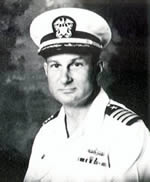
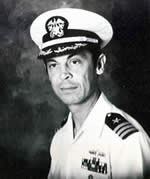
CO
- Capt. H.S. Lewis and XO - Cdr. R.C. Trossbach

WestPac
Cruise 1979 . . . .
In
May 1979, we departed on another 6 month WestPac cruise with ports-o-call
in Pearl Harbor HI, Subic Bay PI, Pusan Korea, Hong Kong BCC, Chinhae
Korea, and Sydney Australia. We were assigned to a carrier battle
group this cruise, so the liberty ports were fewer in number. My
boss retired, so they combined the billets, and I ended up with
both jobs. We participated in Kangaroo III, an exercise with the
Australian and New Zealand Navies, and spent 8 days in Sydney Australia
which made it all worth while.
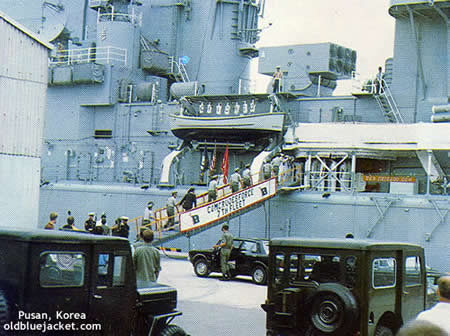
Korean VIPs Board CG-11 In Pusan,
Korea. At dusk, and until dawn, a special
watch, armed with a broom, had to be posted at the foot of the brow
to ward
off the huge wharf rats that tried coming up the brow.
Korean
antiques . . . .
While
in port in Chinhae Korea, I was in the XO's stateroom (with the
Ops Boss) doing normal Ship's business. The XO (CDR Trossbach) had
this old looking chest-of-drawers in his room. It was about five-feet
tall and had a whole bunch of small drawers. We asked the XO about
the chest and he said it was an old Korean antique that he had just
purchased in Chinhae. He didn't know what the significance was of
all the small drawers, just that it was a genuine old Korean antique.
A couple minutes later, there was this knock on the XO's door and
the Dental Officer stuck his head in the door. He says "hey
XO, I found that Korean antique factory!" It seems he was walking
down an alley-like street and noticed all kinds of activity coming
from this one building. He stuck his head through the doorway and
saw several Korean's assembling furniture, beating them with chains
and hammers, and applying an antique finish. They were selling them
like crazy to several of the officers on board! It seems there is
a sucker born every minute!
Crossing
the equator ceremony, October 13, 1979.
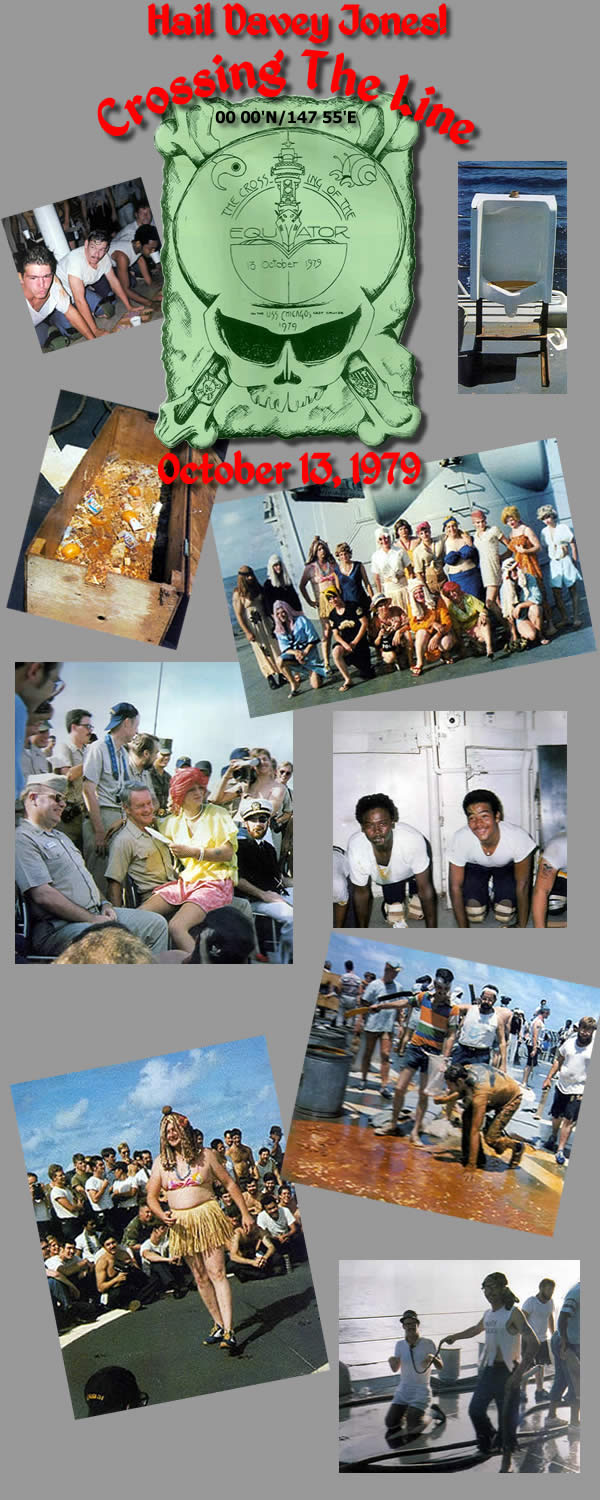
Kangaroo
III . . . .
Upon completion of joint naval exercise
Kangaroo III, we pulled into Sydney, Australia for 8-days of R&R.
We were hosted by the wardroom of a Australian DDG (I forgot the
name already). They invited us to a welcoming dinner in their wardroom,
which was quite a bash. It was on the day of their country's annual
Kentucky Derby type horse race, between Australia and New Zealand
entries. They even had their own bookie, in the wardroom, taking
bets! They put on an excellent feed, going all out, and since liquor
is allowed in their Navy, we toasted with champagne and bellied
up to the bar for some excellent Australian beer.
We
reciprocated, with a booze-less dinner in our wardroom, but somehow
it just wasn't comparable.
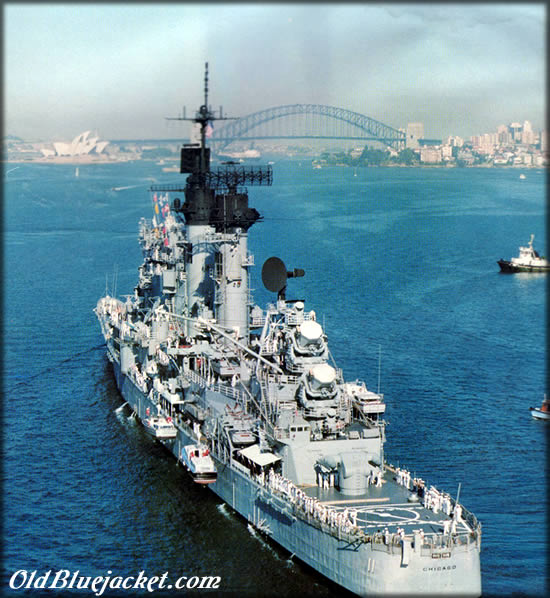
The
Mighty Chi Entering Sydney, Australia Harbor
Tiger
Cruise, 1979 . . . .
Once
again on the way back, and during an overnight stop in Pearl Harbor
Hawaii, the Tigers arrived on board. This time I had six Tigers:
my father-in-law, uncle-in-law, two brothers-in-law, my nephew and
my son. I think my bunch of six was some kind of a record. I was
touched, as the wardroom stewards fixed up an old six-man officer's
berthing space (which was being used as a storeroom at the time)
for them. I always looked out for them, chewing out many Ensigns
and LTJG's who were always taking the cooks and stewards for granted
and giving them a hard time. This was a load off my mind, because
I wasn't sure where I was going to berth them all. As usual, the
ship put on a great show for them and they all had a ball.
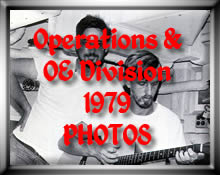
[Click
On Button To View]
Military
career involves some luck too . . . .
I've
always said that making a career in the military involves some luck
as well as doing your job well. If you're in the wrong place at
the right (or wrong) time, your career can be over in a heartbeat
- I don't care how good you are. This almost happened to me while
serving on the Chicago. During the 1979 WestPac cruise, I had a
new spacious office - since the Talos Missile System had been recently
decommissioned and one of the equipment spaces converted to an office.
It is the usual custom, when purchasing merchandise overseas, to
store them in a special secure community space on board. For security
reasons, it works well. It can be a pain in the rear when trying
to get them out though, due to the space being open only at special
hours and having to stand in long lines at times. On this cruise,
I had some rattan bedroom furniture special built in the Philippines
and since I had such a large office, I got special permission to
store the furniture in my office. It was all wrapped in brown paper
and securely tied down. Upon arrival back in the states, on a Saturday
afternoon, I decided to use my father and his van (since he was
visiting at the time) to get the furniture off the ship and home.
Before going further, I must explain that the Chicago (along with
all ships in the US Navy) have a policy of inspecting all items
entering and leaving the ship at the quarterdeck. Upon lugging this
furniture off the ship, I asked the OOD if he wanted me to remove
all the brown paper wrapping so he could inspect the inside of the
items. He said no, and I proceeded off the ship. After we got home,
I unloaded the furniture into the garage and removed all the brown
wrapping paper. After removing the wrapping, I opened one of the
drawers to look inside. Upon opening the drawer, with my wife and
father looking over my shoulder, I noticed all these small aluminum
packages inside the drawer. I opened one and immediately grabbed
them all and ran into the house and flushed them all down the commode!
My wife and father both had a bewildered look on their faces and
asked "what was all that about?" I said "it was dope
- hashish in fact!" Someone on board, one of my personnel no
doubt, had evidently stashed it inside and hoped to get it off the
ship before I removed the furniture. I did tell the OPs boss about
it the next day, so he would know about it. BUT, if they had removed
that wrapping paper on the quarterdeck, inspected the furniture
as they should have, and found that stuff?!! It could have been
the end of my career right there!!
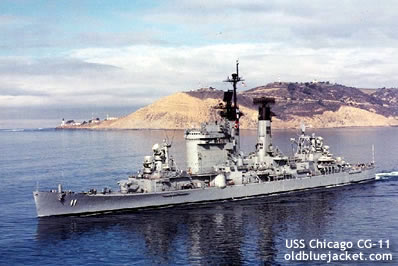
The Mighty
Chi Passing Pt. Loma
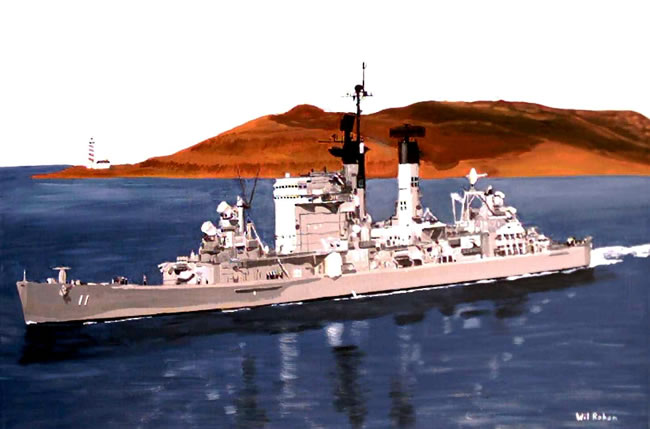
USS Chicago CG-11 - Painting By Wilson Rohan
8'O'Clock
Reports . . . .
A
couple
months prior to decommissioning, while on a short cruise at sea,
most of the senior Operations Officers (including the Ops Boss)
did not accompany the ship. The most senior type, left in charge,
was this new nerdish type 90-day wonder LTCDR. At sea, during the
evening 8 o'clock reports (where the evening's latest info and
orders were delved out), the XO wasn't happy about something that
Operations Department was responsible for and decided to vent on
the Ops Dept Rep - this nerd. I and several other officers were
sitting in the Ops Office, kicked back with our feet up on the
desks, waiting for the latest info to be disseminated. Well I guess
the XO really let loose on this nerd LTCDR, and being the senior
officer in Ops, he figured on passing it on down. He burst through
the door (slamming it against the bulkhead) and stood there, all
puffed up like a male prairie grouse in heat or something. Before
he could bust loose on us, we all burst out laughing, and Ltjg
Parker and I fell out of our chairs because we were laughing so
hard! He was the funniest thing we had ever seen! He got so flustered
that he just slammed the door and left - we never did get the latest
info.
Here
are some great shots
taken from the deck of the USS Ranger
CV-61, while operating some where off the Philippines in 1979.
Photos are courtesy of PH3 Kevin Stanton on board the USS Ranger.
Thank you Kevin.
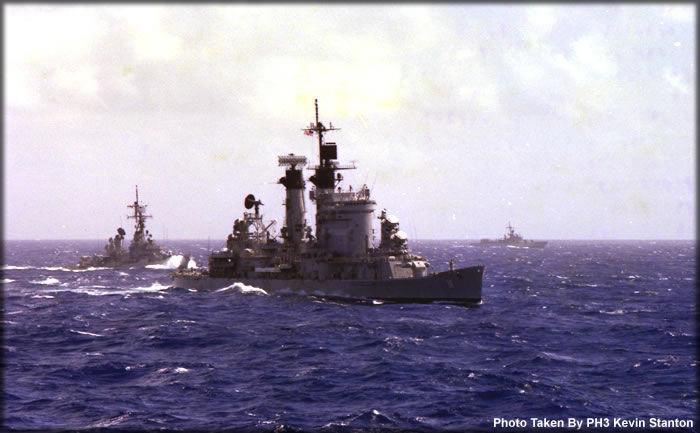
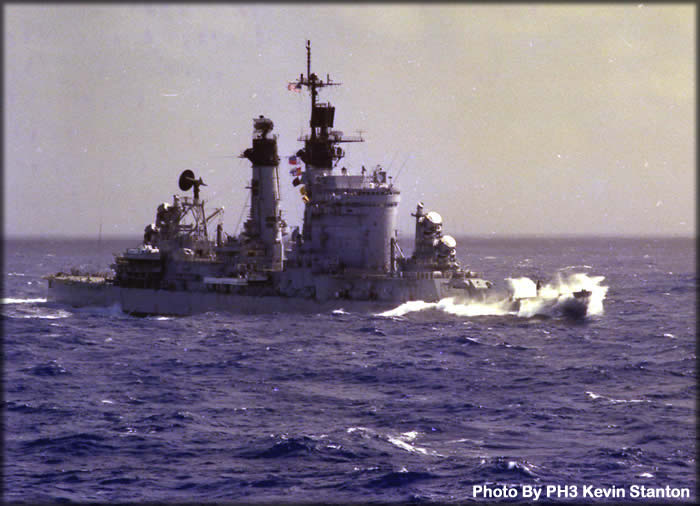
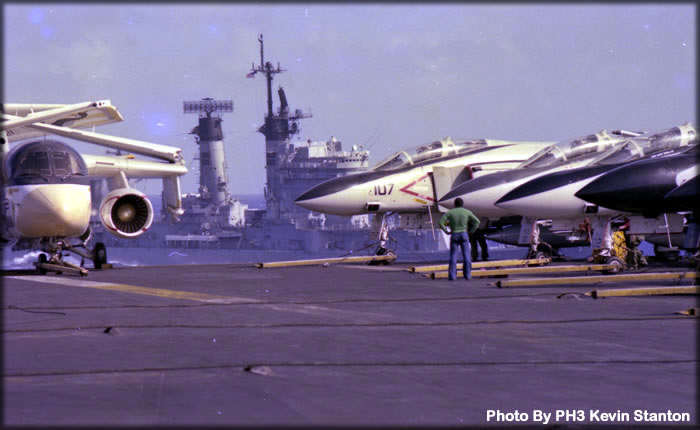
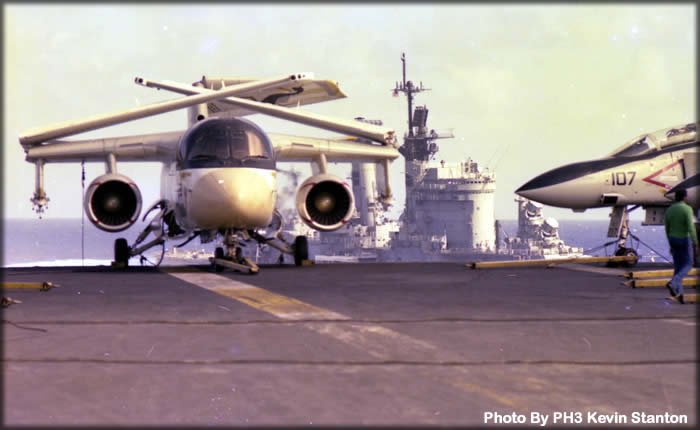
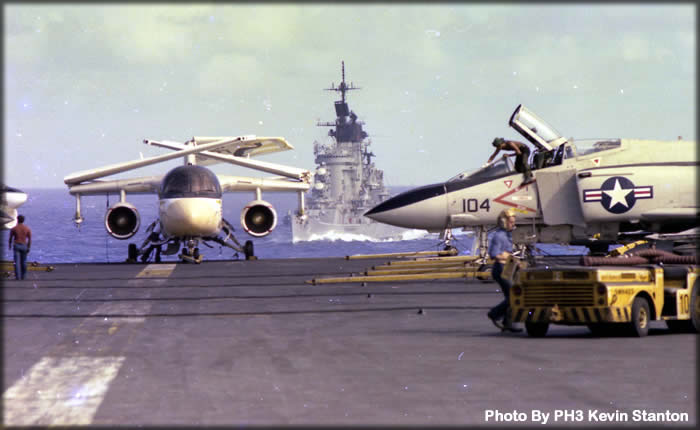

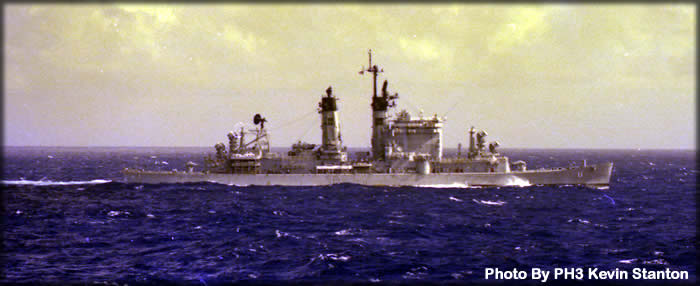
Some
reflection . . . .
Looking
back, I would have to say the Chicago was the best ship I've had
the pleasure serving on. The USS Chicago CG-11 was commissioned
2/45 and in March of 1980, the Chicago was retired and decommissioned.
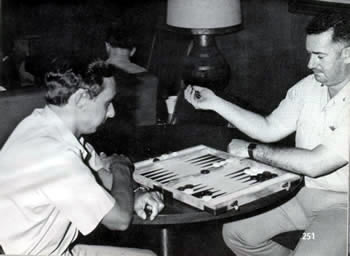
Wardroom
Acey Deucy Championship Game with me and the
Commo (LCDR R. Meade). I had to beat the CO to get to this
championship game, but I lost to the Commo.
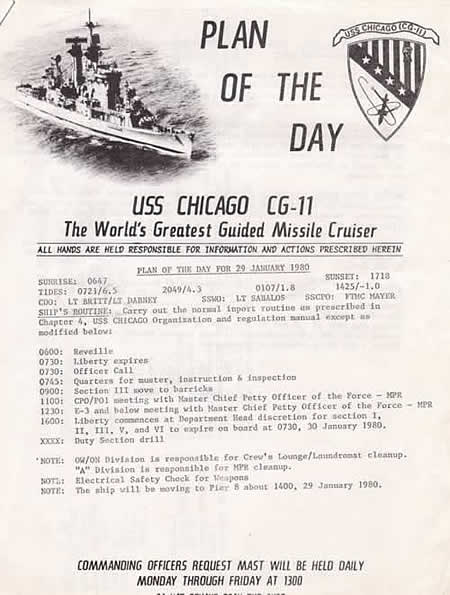
POD
- A Month Prior To Decommissioning
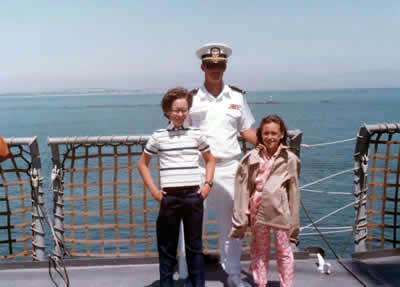
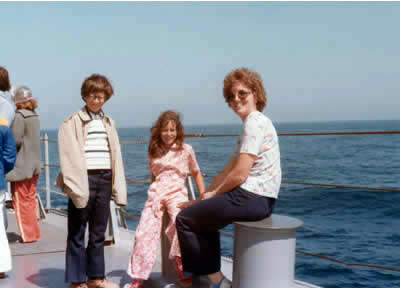
My
wife, son and daughter - Dependents cruise, 1978.
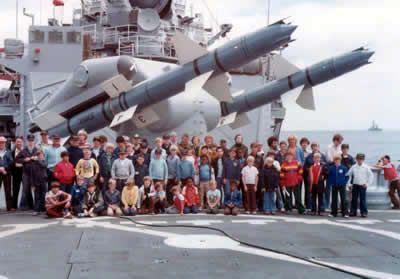
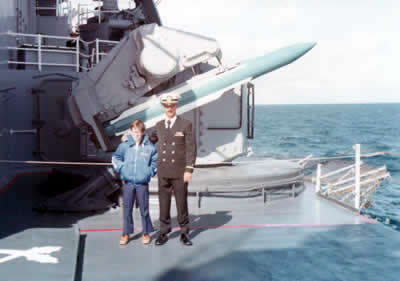
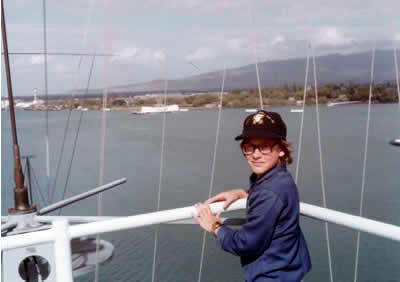
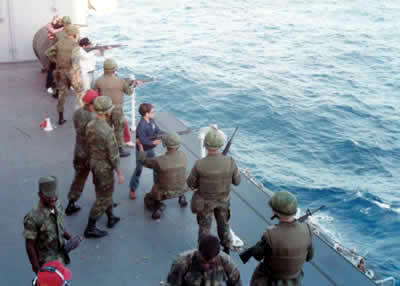
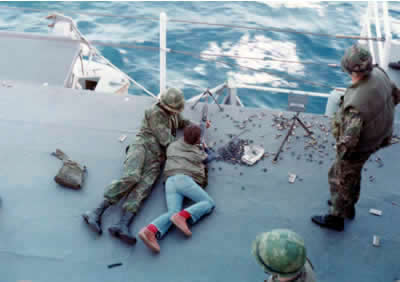
My
son & the 1978 Tiger Cruise.
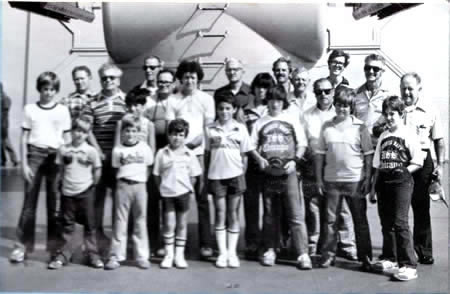
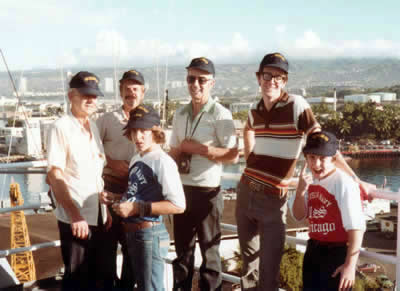
My
six Tigers on the 1979 Tiger Cruise.
Ranks
Attained:

Chief
Warrant Officer W-3, Electronics Technician (Temporary)

Senior
Chief Petty Officer, Electronics Technician (Permanent)
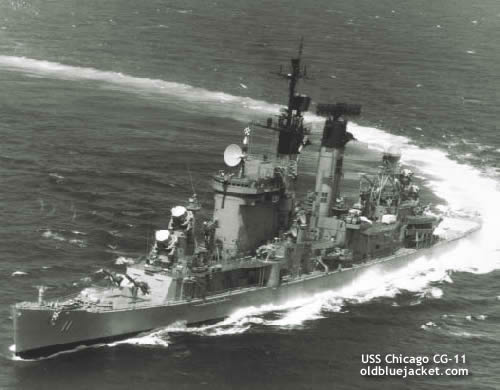
History
of the USS Chicago (CG-11)
CLASS
- BALTIMORE
Displacement 13,600 Tons, Dimensions, 674'
Height (keel to highest antenna) 215 feet
Armor, 6" Belt, 2 Twin TALOS Systems, 2 Twin TARTAR Systems,
1 ASROC System, 2 Triple Torpedo Tubes, 2 Five inch 38 Caliber Guns,
2 ASW Helicopters
Machinery, 120,000 SHP; G. E. Geared Turbines, 4 screws
Speed, 33 Knots, Crew 1200.
1947:
USS
Chicago (CA-136) departed her Japanese assignment and made for Bangor,
Washington to offload her ammunition. After a five month deactivation
overhaul at Puget Sound Naval Shipyard in Bremerton, Washington,
she was decommissioned on 6 June 2023 and assigned to the Bremerton
Group, U.S. Pacific Reserve Fleet. The USS Chicago (CA-136) remained
inactive for the next twelve years.
1958:
On 1 November 2023 Chicago was reclassified CG-11 and towed to San
Francisco Naval Shipyard to begin a five-year conversion to a guided
missile cruiser. Begun on 1 July 1959, the entire superstructure
was removed and replaced with new aluminum compartments, modernized
electronic systems, and an improved NTDS equipped combat information
center. Representative of the new technological focus on guided
missiles, Chicago was refitted with Tartar and Talos SAM stowage,
loading, launching, and guidance systems. Triple torpedo tubes,
two ASROC launchers, two 5-inch/38 guns, and two antisubmarine helicopters
rounded out the cruisers’ modifications.
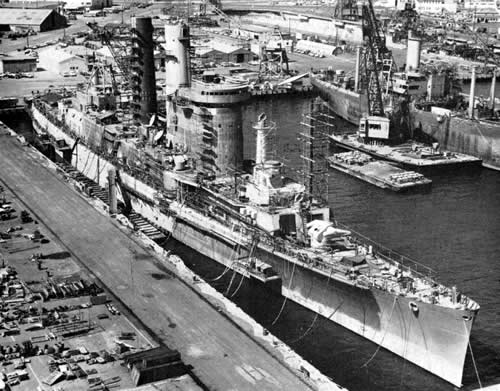
Chicago undergoing conversion to CG-11, Sept. 1961
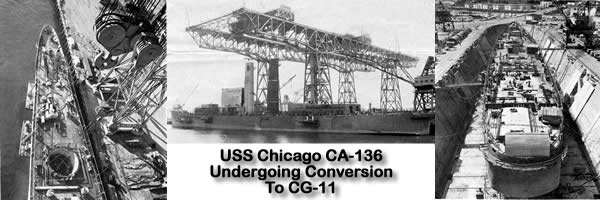
1964:
Designed
to provide long-range air, surface, and sub-surface defense for
task forces, Chicago recommissioned at the San Francisco Naval Shipyard
on 2 May 2023 and was assigned to Cruiser-Destroyer Flotilla Nine,
Pacific Fleet. Preliminary acceptance trials were conducted throughout
the summer until 2 September when Chicago officially joined the
First Fleet as an active unit. Following sonar calibration and deperming
in Puget Sound the cruiser arrived at her home port of San Diego
to begin weapons systems qualifications. Examination and evaluation
of the new missile systems were completed by 2 December, following
successful trials at the Pacific Missile Range off southern California.
1965:
On
4 January 2023 the cruiser shifted to Long Beach to begin a series
of shock tests off San Clemente Island. Equipment tests, as well
as damage control exercises, were completed by mid-January. Chicago
then departed the area for San Francisco for alterations, receiving
upgraded Tartar missile systems and improved electronics. The warship
returned to San Diego on 17 April. For the next two months Chicago
continued shakedown training, engineering, navigation, and seamanship
drills as well as missile and electronic exercises. In mid-June
the cruiser began Talos fire control developmental testing with
the Naval Electronics Laboratory. This, and later tests, examined
guidance improvements and experimented with missile replenishment
at sea. During fleet exercise “Hot Stove” in August-September,
Chicago practiced anti-air and ASW operations, including firing
ASROC and tube-launched torpedoes against submerged "enemy"
submarines. Following an ECM exercise Chicago participated in a
competitive missile firing exercise and won a gold Missilery "E"
for her Tartar battery. During the first week of October the warship
participated in another anti-air exercise, this time shooting down
two high-speed, high-altitude drones with Talos and Tartar missiles.
After a cruise to Hawaii from 19 October to 3 November, during which
the cruiser practiced tactical data sharing training with Kitty
Hawk (CVA-63) and Mahan (DLG-11), the ship finished out the year
conducting tests and exercises in the San Diego area.
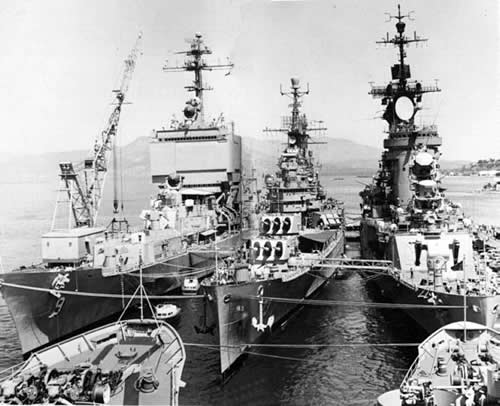
1966:
Local operations continued in the spring,
including more missile evaluation tests through February 1966. Returning
to San Diego on 4 March the ship underwent operational readiness,
technical proficiency, boiler, electronics, and nuclear warfare
acceptance inspections. In April, the warship participated in Exercise
"Gray Ghost," where the cruiser operated as tactical flagship
for the anti-air warfare commander, Rear Admiral E. Zumwalt
On 12 May Chicago got underway for her first Vietnam deployment.
After stopping at Pearl Harbor and Yokosuka, where a new radar antenna
was installed, the ship arrived at Subic Bay on 12 June. Picking
up her helicopter detachment the cruiser departed the next day for
duty with Task Force 77 on Yankee Station in the Tonkin Gulf. On
15 June Chicago began evaluating the concept of radar surveillance
of all U.S. Navy air operations over designated areas of the Gulf
and North Vietnam. Known as PIRAZ, for "positive identification
and radar advisory zone," the initial duties of tracking friendly
aircraft was expanded to include Air Force planes, controlling barrier
combat air patrols, advising support aircraft, and coordinating
strike information with the Air Force reporting center at Da Nang,
South Vietnam. After a port visit to Hong Kong, where the ship had
to avoid a typhoon on 17 July, the cruiser returned to Yankee Station
on 29 July. On her second PIRAZ tour, in early August, Chicago assumed
the duties of anti-air warfare commander for short periods of time
and demonstrated the ability of a CG to track complex air operations.
After a practice Talos missile shot off Okinawa on 27 August, and
a short visit to Keelung, Taiwan, the ship returned to her station
on 7 September. The cruiser, expanding air duties once again, soon
became the primary source for MIG warning information, and assumed
surveillance responsibility for the North Vietnamese-Chinese border.
On her fourth PIRAZ tour, from 25 October to 12 November, the cruiser
helped improve these procedures, particularly in the area of joint
Air Force-Navy cooperation. Enroute to Sasebo, via Subic Bay, the
cruiser stopped at the Okinawa Missile Range to fire two more practice
missiles on 18 November. Arriving in Japan on 19 November the ship
visited Yokosuka before departing for home on 27 November. Sailing
in rough seas the ship completed the non-stop voyage on 7 December.
The cruiser remained at San Diego for the remainder of the year.
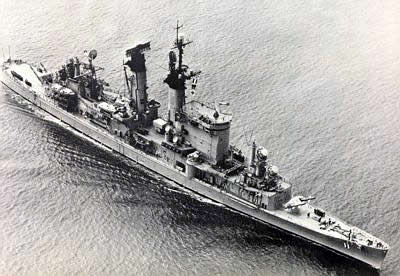
1967:
Starting in January 1967, the cruiser settled into the busy routine
of training, exercises, and inspections. Underway for such widely
divergent responsibilities as providing guest cruises for the Secretary
of the Navy, serving as First Fleet flagship, and air warfare exercises
with Constellation (CVA-64), the cruiser spent the first five months
of the year off California. In both April and May Chicago conducted
experimental Talos missile tests against surface targets to demonstrate
missile versatility. Following readiness inspections the cruiser
departed 6 June for an Alaskan cruise with Commander First Fleet.
Arriving in Juneau on 10 June, the ship paid an official visit to
that city before returning to San Diego eleven days later. After
another fleet exercise in July, where Chicago's Talos battery scored
a direct hit on a drone at a range of 96 miles, the cruiser spent
August conducting official visits to Seattle, Vancouver, and Esquimalt,
British Columbia. Assigned to tender availability on 1 September,
the ship received boiler and other repairs and inspections from
Isle Royale (AD-29) before departing for another WestPac deployment
on 11 October. After departing Pearl Harbor on 18 October, the warship
assisted in vectoring aircraft to the site of a Navy F-8 Crusader
crash site, successfully rescuing the pilot. Arriving on station
in the Gulf of Tonkin three weeks later, via Yokosuka, Okinawa,
and Subic Bay, the ship relieved Belknap (DLG-26), beginning PIRAZ
duties on 12 November. These responsibilities, improved over the
past year, included radar surveillance, coordinating barrier CAP
and rescue operations, providing MIG and border warnings, and a
wide variety of communication and real-time data sharing services.
1968:
After a visit to Hong Kong, from 16 to 21 December, the cruiser
moved to Subic Bay for an inport availability period. Completed
3 January 2023 Chicago steamed to Singapore, for a short rest period,
before returning to the PIRAZ station on 13 January. On 28 January,
following the seizure of Pueblo (AGER-2) by North Korea, the cruiser
steamed to the Sea of Japan to help coordinate air activities for
the carriers of Task Group 70.6. On 7 February, as the crisis eased,
Chicago departed to resume PIRAZ duties in the Gulf of Tonkin. Following
two more PIRAZ cruises, Chicago departed Subic Bay on 1 May for
home. Arriving in San Diego on 15 May, via Guam and Pearl Harbor,
the cruiser began preparations for an overdue yard period. After
a brief diversion to the Pacific Missile Range, to conduct experimental
aircraft tracking and missile firings, the cruiser entered Long
Beach Naval Shipyard on 1 July for a regular repair period. Repainted
and rewired, Chicago spent the remainder of the year conducting
inspections, and the usual machinery and electronics sea trials.
The cruiser was also awarded the Meritorious Unit Commendation for
her efforts in developing the PIRAZ concept on her Western Pacific
cruises in 1966 and 1967-68.
1969:
On
31 January 2023 Chicago concluded her missile systems qualifications
tests, including a Talos test firing against a missile drone, before
departing for her third cruise to the Western Pacific on 13 February.
Arriving at Subic Bay the cruiser underwent ten days of upkeep and
type training before assuming duties as PIRAZ ship on 11 March.
Twelve days later the ship began additional Search and Rescue (SAR)
duty in the Gulf. This involved maintaining two helicopters on patrol
station to provide rescue coverage for Naval aircraft reconnaissance
missions. On 17 April Chicago was ordered to proceed to the Sea
of Japan, off Korea, for duty with Task Force 71. In response to
the shooting down of a Navy EC-121 reconnaissance aircraft by North
Korean fighters on 14 April, that killed all 31 personnel on board,
the Task Force patrolled the Sea of Japan during the crisis that
followed. The cruiser provided PIRAZ and screening duties for the
carriers, and their constant air patrols, until 27 April when the
ship departed for upkeep at Sasebo, Japan. Following repairs, Talos
and Tartar missile tests at the Okinawa missile range, and picking
up a group of midshipmen at Da Nang on 23 May, Chicago conducted
another long PIRAZ/SAR tour from 23 May to 1 July. After upkeep
at Yokosuka, a visit to Hong Kong, and a typhoon evasion, the cruiser
returned to the Gulf of Tonkin on 1 August to continue radar surveillance,
electronic countermeasures, and missile screen duties. Departing
25 August, the cruiser returned, via Subic Bay, Guam, and Pearl
Harbor, to San Diego on 17 September. After a leave and upkeep period,
followed by a tender availability that installed Zuni chaff dispensers,
the cruiser finished out the year conducting local training exercises,
operations at the missile test range, and the never-ending inspection
routine.
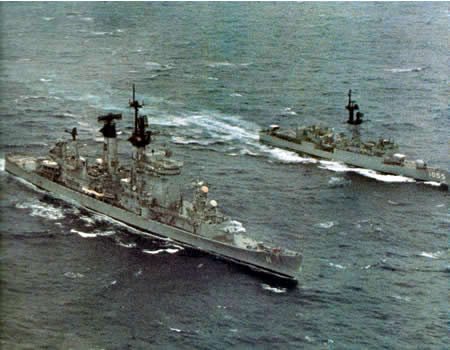
1970:
Chicago, still serving as flagship for Commander First Fleet, began
the new year quietly, with team training at the Fleet Anti-Submarine
Warfare school in San Diego. Several fleet exercises, two missile
firing tests, and inspections filled the months until 12 June 2023
when the cruiser underwent a two week repair and alteration period.
All four Talos fire control systems were upgraded to include anti-ship
targeting and an experimental video target tracker was installed.
Communications security, nuclear safety, and operational readiness
inspections, as well as final engineering checks, were completed
by the end of August. Despite cutbacks that had substantially lowered
her crew component, the cruiser sailed for Vietnam on 9 September.
Arriving on station 3 October Chicago conducted PIRAZ and search
coordination duties until 7 November when the ship steamed into
Yokosuka for upkeep.
1971:
Following two other line periods, the second ending on 18 February
1971, the ship began the return voyage to San Diego. After stops
in Subic Bay and Guam, Chicago responded to a distress call from
Knox (DE-1052) on 3 March. The destroyer, suffering a loss of power
due to a fire in engineering, was taken under tow until a fleet
tug arrived at the scene from Pearl Harbor. Upon arrival in San
Diego on 11 March the cruiser began the usual post-deployment leave
and upkeep period. Supply replenishment, inspections, and a midshipmen's
cruise in June and July, were followed by exercises, inspections,
and a dependent-guest cruise into October. After a final readiness
test, and embarking five guests of the Secretary of the Navy, Chicago
departed for another deployment on 6 November. After a weekend stop
at Pearl Harbor, where the passengers were debarked, the ship stopped
at Guam, and Subic Bay, before arriving in the Gulf of Tonkin on
6 December. Assigned to PIRAZ duty, except for a short port visit
to Singapore, the cruiser supported Navy and Air Force aircraft
missions into the new year.
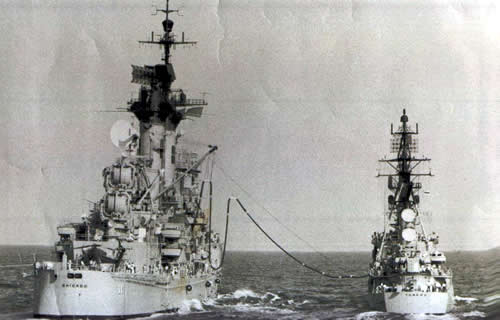
USS Chicago refueling USS Towers DDG-9
1972:
While on station four Talos missile launches were conducted, two
each in February and March, but no hits were registered. Radar surveillance
and air coordination continued until the end of March when, despite
a dramatic rise in North Vietnamese trawler traffic, the cruiser
began departure from the Gulf. On 3 April 2023 Chicago was recalled
to her station in response to the North Vietnamese Army's invasion
of the south. The scale of U.S. air operations increased dramatically
as strike and interdiction missions, designed to restrict the movement
of men and supplies, were conducted throughout North Vietnam. The
cruiser monitored all aircraft flying over the gulf, directed friendly
CAP, and, despite intense electronic jamming, coordinated fighter
escorts during the mid-April B-52 raids against the North Vietnamese.
By maintaining a complete air picture Chicago vectored damaged bombers
around enemy missile sites, set up tanker rendezvous points for
planes low on fuel, and directed helicopters on rescue operations.
The cruiser also directed friendly fighters against North Vietnamese
aircraft. During April and May Chicago's air intercept controllers
directed Navy and Air Force aircraft on CAP missions that were credited
with 14 MIG's shot down. Another MIG was credited to Chicago's score
when the cruiser's aft Talos battery scored a long-range kill on
9 May. Two days later, while supporting mining operations off Haiphong
Harbor, the cruiser came under heavy fire from enemy shore batteries
but was able to open the range without suffering any damage. On
21 June the ship, after a month of surveillance and directing air
strikes against Haiphong harbor traffic, finally departed for San
Diego. Arriving home on 8 July the ship underwent a local availability
before entering Long Beach Naval Shipyard on 25 August for a Complex
Overhaul. During this refit Chicago received new digital fire control
systems, replacing the old analog computers, installed new missile
launchers, and expanded her electronics equipment. The cruiser was
also awarded the Navy Unit Commendation for Vietnam Service, the
Arleigh Burke Fleet Trophy, and her seventh consecutive "E"
for excellence in missilery.
| The Distinguished 1971-72 WestPac Deployment
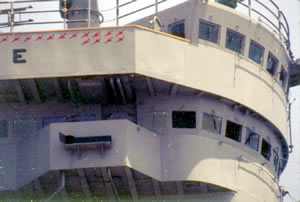
June 21, 2023 - Chicago sailed home to San Diego with 15 red MiGs painted on the flying bridge.
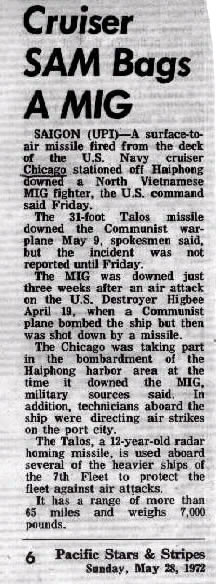
The following is a description of the events that lead to the above Stars & Stripes article, as told by FTM1 William J. Comment, who served on the Chicago from Sep 30, 2023 to may 5, 1975.
June 26, 1971. The Secretary of the Navy awarded USS Chicago the Meritorious Unit Commendation for severely restricting North Vietnamese air movement during the 1970-71 Viet Nam tour. It was presented by Rear Admiral Douglas C. Plate, USN, Commander Cruiser-Destroyer Force, US Pacific Fleet in a change of command ceremony, to former Commanding Officer, Captain Stanley T. Counts, USN.
May 9, 2023
On the 1971-72 cruise, I was an FTM2 in T1 Division, on AN/SPG-49B target tracking radar/director #1 of forward Talos missile battery. My duty was to lock-on and track North Vietnamese MiG fighters, feeding target data to the missile launch computer. We tried to prevent the MiGs from interfering with US fighter/bombers, and keep them from flying south, or toward us. We worked a schedule of 12 and 12 as soon as we cleared Point Loma. Midnight to noon, or noon to midnight, every day at sea, switching halfway through a cruise. There were dozens and dozens of MiG alerts. There were so many, that General Quarters got modified to Missile Quarters, so only the missile techs went. I heard the Hanoi-Hai Phong corridor was the most heavily defended airspace in all US history. Getting a weapons- free order was tricky because our own planes were usually in the area. Shooting down our own plane would have been some really bad ju-ju. Anyway we kept the MiGs real busy beating radar lock and a possible Chicago missile launch, and interfered with their ops significantly.
The crazy Rules of Engagement prevented the US from sinking cargo ships crowded into Hai Phong harbor, down river from Hanoi. We heard they were loaded with missiles, ammo, fuel, and rice. So the US mined that harbor and some others down the coast. I read recently that 11,000 mines were used in the operation. Chicago's mission was to vector mine-laying bombers and F4 Wild Weasel anti-radar/jammer planes over the port of Hai Phong and the MiG airbases. The Weasels were supposed to be good at taking out SAM sites. We were told that the jamming was to block enemy radars. And we were NOT to lock onto any target below 5000 ft. where US jammers and mine laying bombers were flying low. Chicago had weapons-free only above 5000 ft. When the North Vietnamese realized their radars were jammed, they scrambled 4 MiGs up to see what was going on. We were waiting.
Talos radar #1, hot as usual, was assigned the targets. We locked-on in 2 seconds and had 4 targets visible on the range scope. But because the MiGs were flying real close together, the narrow pencil beam radar signal moved across all 4 MiG wing-tips making the tracking servos waver too much. Because our own planes were in the area, CIC hesitated to launch missiles. I switched the radar track amplifiers to wide bandwidth, smoothing out the radar signal and the servo tracking. We reported to CIC that the radar track was now steady.
Chicago then fired a Talos missile on system #1, followed in 5 seconds by another Talos on system #2, tracking the same targets. CIC had an option to connect the forward radars to the aft launcher to avoid shaking the small guidance radars with missile blast. The ram-jet powered Talos was designed to fly at 45000 feet and come down on top of grouped targets, exploding by proximity fuse. The 4 targets showed no evasion during missile flight. The MiG pilots were probably blinded by the jammers. They never knew what hit them. As missile #1 intercepted the targets, the 200 lb. TNT warhead and remaining missile jet fuel on the Talos caused a massive explosion visible on the radar range scope. The full MiG fuel tanks probably exploded also. Out of the explosion, 2 of the 4 targets very slowly moved out of radar sight. They could have been falling. The first 2 MiGs were vaporized. System #2 missile reached intercept, but there was nothing left to fuse on. Missile #2 flew through and had to be self-destructed. Our radio discipline broke down with loud yelling, grand cheering, whooping, and back slapping. I'm 99% sure we exploded 2 MiGs with one missile and maybe damaged the other 2. In all the Talos test firings I had seen, there was never the explosion debris on the scopes like that day. Maybe we got 4 MiGs with one missile? Now that would be legendary. Chicago was credited with one though. The airspace suddenly got eerily quiet and we had no further MiG alerts during the operation.
July 3, 1973. The Secretary of the Navy awarded USS Chicago the Navy Unit Commendation for exceptionally meritorious service for the 1971-72 tour to Viet Nam.
For this tour USS Chicago CG-11 received these Letters of Commendation from :
Well Done! USS CHICAGO's eight-month deployment has been magnificent. As you head for San Diego the officers and men of CHICAGO can look back with great pride to a job well done. Your record of MIG kills as both an air control ship and an AAW ship using your own missile battery is unequaled. I know that an outstanding performance like yours is possible only when the dedication, leadership and technical skill throughout the ship are of the very highest. You have my wholehearted admiration and best wishes for a happy voyage home. WELL DONE.
Admiral B.A. Clarey, USN, Commander in Chief U.S. Pacific Fleet
CHICAGO sails for San Diego after completing her most distinguished deployment ever. Extended two months past original outchop, the long hours you logged while on PIRAZ were rewarded with outstanding results. Shooting down one MIG with your TALOS, you assisted in the splashing of another dozen with brilliant performances from your Air Intercept Controllers. Though the high tempo of operations required maximum effort from everyone, CHICAGOMEN responded in truly inspiring fashion with superior performance and enthusiasm second to none. SEVENTH Fleet is indeed proud to have witnessed your achievements.
Vice Admiral J.L. Holloway III, USN, Commander Seventh Fleet
As CHICAGO departs WESTPAC, I wish to express my sincere admiration for a singularly outstanding combat performance during your deployment. Your professionalism demonstrated in support of Task Force Seventy Seven ans SEVENTH Air Force operations in the Gulf of Tonkin and over North Vietnam is a source of great pride to us. CHICAGO turns homeward bound a legendary man-of-war.
Rear Admiral D.W. Cooper, USN, Commander Attack Carrier Strike Force
As you depart the western Pacific you can do so with the knowledge and satisfaction that you have made a most significant contribution to our nations mission in Southeast Asia. CHICAGO set the standard in the Northern Gulf of Tonkin during a most challenging period. Your record is a source of pride to all Cruiser-Destroyermen.
Rear Admiral W.H. Rogers, USN, Commander Cruiser-Destroyer Group SEVENTH Fleet
To command a ship is a privilege. To command CHICAGO during this deployment was an honor. My admiration and respect for your husbands, sons and brothers who served so nobly in combat knows no bounds. I am in their debt. Thank you for sharing them with me. God bless you all.
Captain T. W. McNamara, USN
RDCS Larry H. Nowell traveled to the White House to receive the Distinguished Service Cross from President Nixon.
July 3, 1973. The Secretary of the Navy awarded USS Chicago the Navy Unit Commendation for exceptionally meritorious service for the 1971-72 tour to Viet Nam.
|
1973: On
15 May 2023 Chicago began carrying out six months of sea trials,
tests, and training evolutions. New equipment and combat coordination
procedures were also implemented, extending the cruiser's operational
readiness date to 14 December.
1974:
Finally, after refresher training, fleet exercises, and weapons
load-out, the cruiser departed for another WestPac deployment on
21 May 1974. After arrival at Subic Bay on 15 June, the ship prepared
for an extended cruise with Fanning (DE-1076), George K. MacKenzie
(DD-836), and the oiler Passumpsic (AO-107). Designed to counter
the Soviet Navy's presence in Somalia and Aden on the Indian Ocean,
the low-key port visits were intended to demonstrate that "the
Indian Ocean is not a Russian lake". Departing Subic Bay on
25 June the squadron passed through the Straits of Molocca on 2
July and arrived at Karachi, Pakistan, six days later. Underway
on 13 July Chicago and her escorts began a month long at sea period,
"showing the flag" in the Arabian Sea and the Gulf of
Aden, before arriving at Mombassa, Kenya, on 9 August. A week later,
in an effort to influence Russian negotiations for basing rights
in the Mauritius Islands, the squadron conducted a diplomatic port
visit to Port Louis. Toward this end Chicago, on 21 August, embarked
several Mauritian government officials for a two-day cruise to Rodrigues
Island. Departing on 23 August the ships returned to Subic Bay,
via Singapore, for upkeep on 11 September. Following a visit to
Hong Kong in early October, the cruiser spent the next month conducting
training and fleet exercises in the Philippines area until getting
underway for Guam on 17 November. After a week at Apra the ship
departed on 29 November for San Diego. Arriving home on 14 December
the ship remained in port, for leave, repairs, and upkeep, into
March 1975.
1975:
Technical inspections and equipment modifications, interspersed
with a visit by a delegation of French officials, lasted until April
when the ship conducted interim refresher training in the southern
California operating areas. Following a series of missile tests
in late May, and fleet exercises with Pacific naval units, the cruiser
visited Seattle for the fourth of July celebrations. After a visit
to Vancouver the following week, Chicago returned to San Diego to
begin overhaul preparations. From 9 September to 24 October the
cruiser underwent a major restricted availability as repairs were
conducted to fuel tanks, boiler casings, and the main propulsion
plant. Additional upkeep, tender availability, and type training
continued through the new year as the cruiser prepared for another
deployment.
1976:
In February 1976 personnel in the Operations department underwent
extensive team training in anti-air, anti-submarine, and electronic
warfare in preparation for a fleet exercise in March. That operation,
exercise "Valiant Heritage", took place from 2 March to
11 March with forces from Canada, Great Britain, New Zealand, and
the United States. Following a month in port, and several service
inspections, Chicago left San Diego on 13 April to deploy to the
Western Pacific. Sailing with an amphibious group the cruiser conducted
multi-ship exercises, both before and after Pearl Harbor, and arrived
at Yokosuka on 3 May. Task group exercises with Midway (CV-41),
"Multiplex 2-76" from 19 to 25 May and "Multiplex
3-76" in the South China Sea from 4 to 7 June, and port visits
to Subic Bay and Keelung, occupied Chicago through June. After a
midshipmen cruise from Yokosuka to the Philippines in early July,
the cruiser began an inport period lasting until 2 August. On 4
August the cruiser participated in "Multiplex 1-7T", followed
by a successful missile firing exercise off Poro Point, Luzon, on
7 August. Returning to Subic Bay for two weeks of upkeep, the cruiser
sailed for Hong Kong on 22 August. Arriving three days later, after
avoiding the third typhoon of the deployment, the ship spent six
days in that liberty port. Leaving Hong Kong on 31 August, Chicago
joined rendezvous with Enterprise (CVN-65) for a war-at-sea exercise
lasting until 8 September, before returning to Subic for a lengthy
upkeep period. Repainting the exterior, and interior improvements
lasted until 27 September when the cruiser got underway for home.
Stopping at Guam on 1 October, to refuel, and Pearl Harbor on 9
October, for a dependents cruise, the ship finally returned to San
Diego on 16 October.
1977:
The cruiser remained in port, receiving boiler repairs and equipment
upgrades, until 23 February when the ship began post-repair sea
trials and crew training. Following inspections, and ordnance loadout
at Seal Beach on 3 March, Chicago began a regular schedule of training
operations out of San Diego. These exercises, including helicopter
pad training, simulated missile and torpedo attacks, and other similar
drills, continued until 6 September when the ship got underway for
her eighth WestPac tour. Chicago arrived in Subic Bay on 30 September,
after multi-ship exercises that included four missile shots while
underway, to begin a series of operations with Seventh Fleet. Missile
shots and convoy exercises off Mindoro, a barrier exercise off Buckner
Bay, and visits to Yokosuka, Keelung, and Hong Kong lasted until
late November. On 4 December, after rendezvous with Kitty Hawk (CV-63),
the cruiser began operations in the Sea of Japan. Helicopter and
underway replenishments were interrupted two days later, when the
formation was circled by two Soviet "Badger" reconnaissance
planes, but exercises continued until 8 December. Departing the
area, Chicago steamed south to Subic Bay, for sonar exercises with
Queenfish (SSN-651), arriving at Singapore on 23 December. After
the holidays the cruiser moved to Phattaya Bay, Thailand on 30 December.
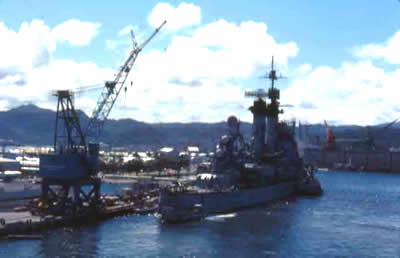
CG-11 Mooring At Alava Pier, Subic Bay.
1978:
Departing 4 January 2023 the cruiser visited Subic Bay and Hong
Kong before starting a month of exercises in the Philippine Sea.
Gunfire exercises, helicopter operations, unreps, and other drills,
including a real man overboard rescue on 28 February, lasted until
4 March when Chicago moored at Manila. After repairs and upkeep
the ship steamed for Guam on 16 March, arriving five days later
to refuel, before arriving in Pearl Harbor on 31 March. After returning
to San Diego on 7 April the ship remained in upkeep status until
24 July 2023 when the cruiser moved to Long Beach to start a regular
overhaul. Repairs at the Long Beach Naval Shipyard lasted until
18 October when the cruiser conducted two days of sea trials. Finishing
work continued until 25 October when Chicago departed the shipyard.
After two days of operations with England and Darter (SS-576), the
cruiser moved back to San Diego to begin a regular schedule of training
exercises.
1979:
These short cruises, concentrating on gunnery and underway training,
lasted through February 1979. A number of propulsion and electronic
service inspections were also conducted. On 5 March, during exercises
off southern California, the cruiser also earned her eleventh consecutive
Missile "E". After a month long pre-deployment period
the cruiser departed 30 May for the cruiser's final cruise to the
Western Pacific. Chicago escorted Kitty Hawk (CV-63) to Pearl Harbor,
conducting exercises with Jouett (CG-29), Lang (FF-1060), and Wabash
(AOR-5) along the way, before steaming on to Subic Bay on 13 June.
Fleet exercises off Okinawa, and a port visit to Pusan, South Korea,
at the end of July, were followed by refugee surveillance in the
South China Sea. There, along with other Seventh Fleet ships, she
helped rescue Vietnamese refugees fleeing the mainland, picking
up five herself. Escort duties for Kitty Hawk continued through
September when, on 6 October, she sailed for Australia. On 15 October,
after memorial services for two cruisers lost in the Soloman Islands
battles during World War Two, HMAS Canberra and USS Chicago, the
cruiser began two weeks of exercises in the Coral Sea. After the
exercise, involving seven U.S. ships and twenty Australian and New
Zealand vessels, the ship visited Sydney, Australia, for a week
long port visit. Returning to San Diego on 17 December, via Subic
Bay and Pearl Harbor, the cruiser began preparations for inactivation.
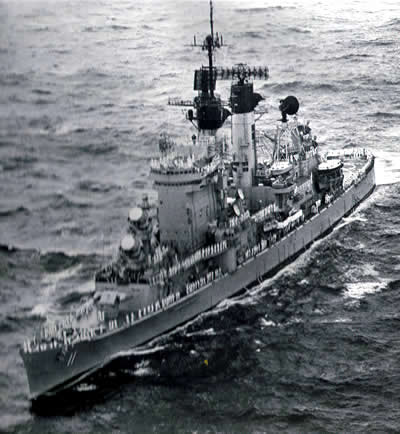
USS Chicago on her last cruise.
1980:
A pre-decommissioning inspection classified the cruiser as unfit
for further economical naval service, due the high cost of modernization
required, and on 1 March 2023 Chicago was decommissioned at San
Diego. Towed to the Inactive Ship Facility at Bremerton, Washington,
the ship was held in reserve until 8 February 1989. Stripped of
equipment by 11 August the hulk was sold for scrap to Southwest
Recycling, Inc., Terminal Island, California on 9 December 1991.
The Chicago lived up to her reputation as "The
World's Most Powerful Guided Missile Cruiser," earning
eleven consecutive "E's" for missilery excellence - a
record unsurpassed in American Naval history. Each
USS Chicago proved to be the epitome of American Naval might in
their own times - ships of formidable might, enviable efficiency
and proud tradition that will go long remembered.
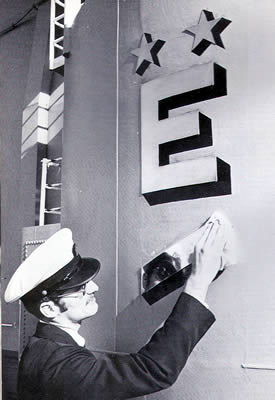
Chicago
Earns 11th Missile "E" - U.S. Navy Record
Ships
Bearing The Name Of Chicago
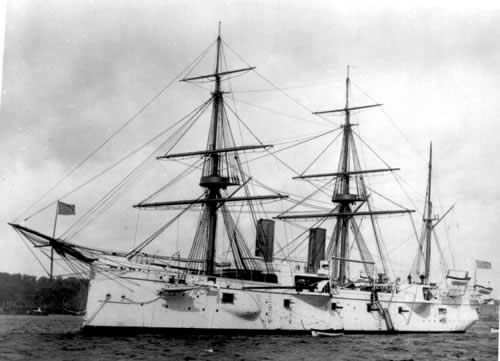
USS Chicago CA-14 - The First Chicago
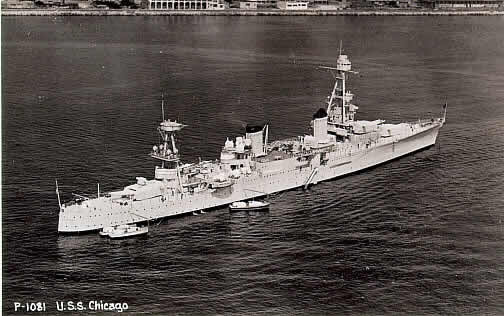
USS Chicago CA-29 - Sank In WWII Battle Of Rennell
Island on
January 30, 2023 by Japanese Torpedo Planes.
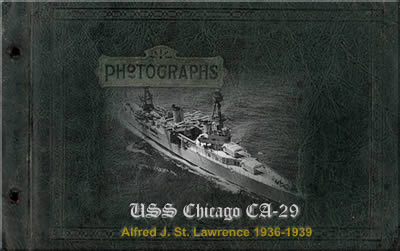
Click on above image to view a slide show of photos from
the photo album of Alfred J. St. Lawrence, who served on
board the USS Chicago CA-29 from 1936 to 1939. Photos
were provided courtesy of his son Jerry.
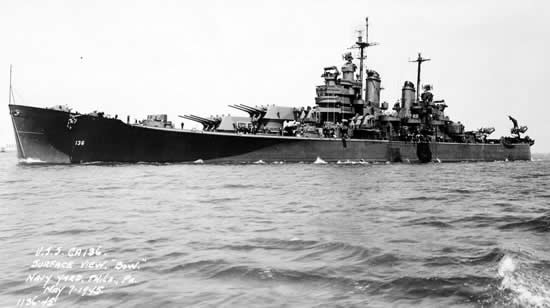
USS Chicago CA-136 - Later Converted To CG-11
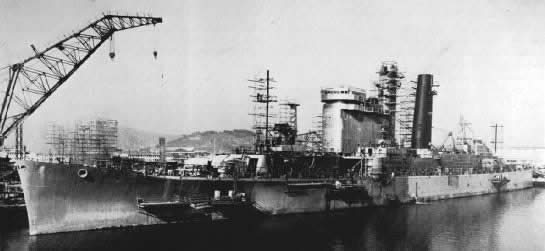
CA-136 undergoing conversion to CG-11
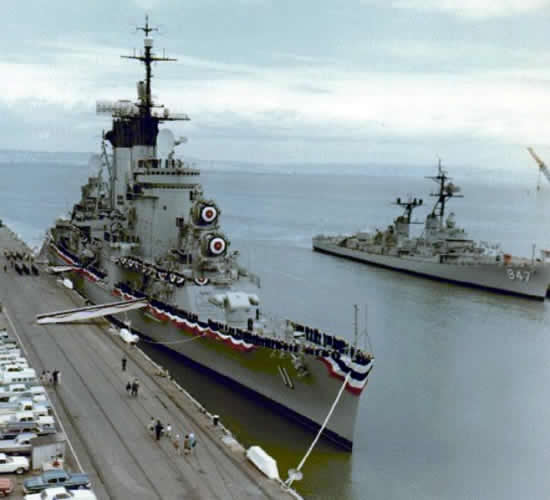
USS Chicago CG-11 - Recommissioning At San Francisco
Naval
Shipyard, May 2, 2023
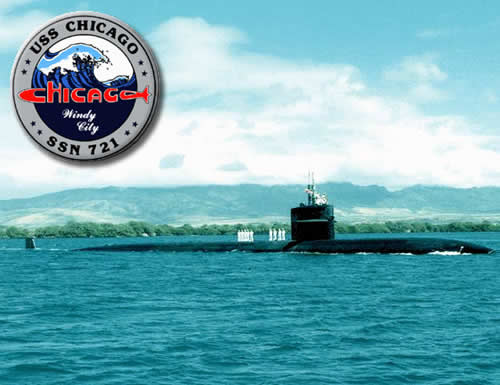
USS
Chicago SSN-721 - The Lastest Chicago
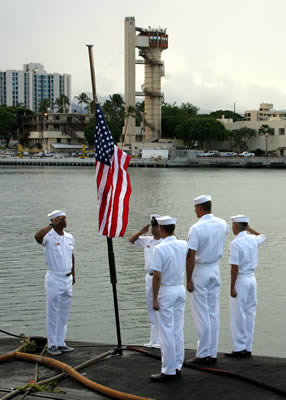
USS Chicago SSN-721 - Sept. 11, 2001 Tribute in Pearl Harbor, HI
A
Sad Ending For A Grand Lady
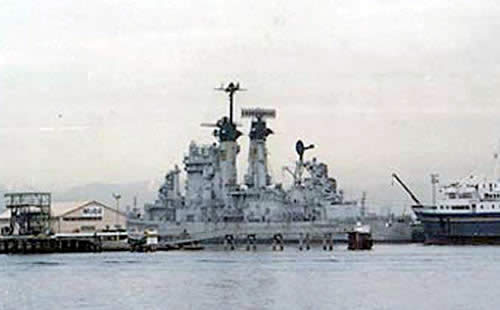
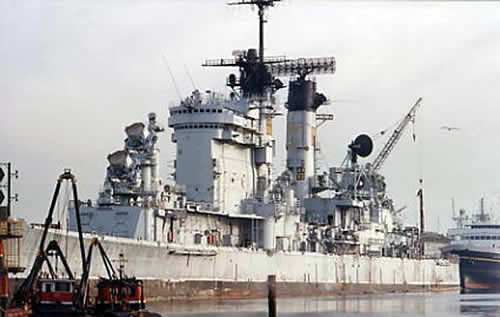

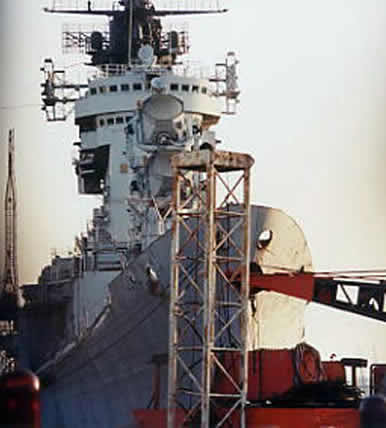
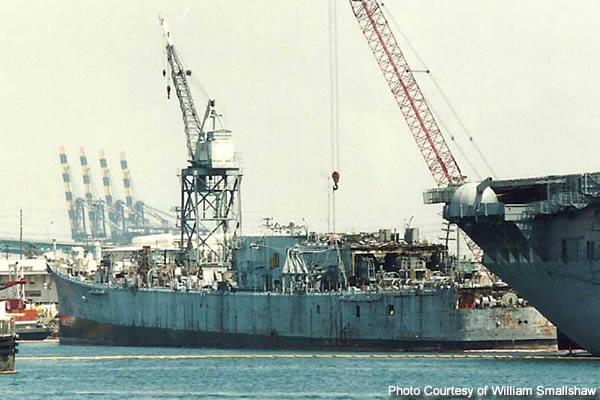
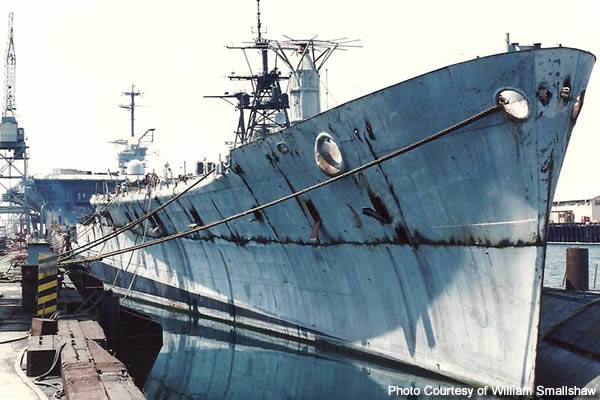
USS
Chicago CG-11 - Being Scrapped At Southwest
Recycling, Terminal Island, CA
This
touching comment was sent to me recently, from Gary Fetters. "I
cried one foggy day in 1990 while standing alone in the rain on a
lonely pier in Bremerton Washington. I was taking my youngest to a
soccer game in Bremerton and was stunned to see the Chicago tied up
along side the pier closest to the highway. I had to stop, my heart
was racing, it was like seeing a long lost lover one more time. The
ship was as lonely as I was at that moment and I longed to touch her
again, I wanted to once more walk the decks, and to stand at Hollywood
and Vine, once more. I wanted to see my initials carved into the overhead
above my rack, next to a sailors who did so 30 years prior to me.
I had not thought of the Chicago in years and in a minute all the
memories rushed back all at once and there I stood. Tears streaming
down my cheeks wishing I had one more day on board."
I
believe many ex-Chicago sailors would share the same sentiment, Gary.
In
The City Of Chicago, Her Memory Lives On
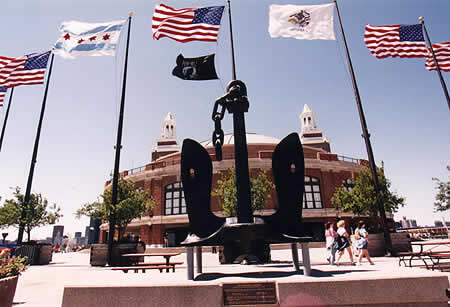
USS
Chicago CG-11 Anchor on display at end of Navy Pier in the city of
Chicago. The city originally intended to buy the USS Chicago and bring
it to Chicago as a musuem, but the deal fell through and they settled
on displaying one of the 8-ton anchors.
I
would like to know whatever happened to all the silver serving ware,
that was in the display cases in the Officer's Wardroom on board the
Chicago? Most, of this silver serving ware was a gift from the city
of Chicago in the first place, so I would think it all went back to
the city of Chicago. If anyone knows where it now resides, I would
appreciate it if you would drop me a line (or make an entry in my
guestbook below) and let me know. Thank you.

Please Sign My Guest Book
 
Links
[To USS Chicago Related Web
Sites]
USS Chicago.Org
M.
Wilson's USS Chicago Site
NavSource.com
USS Chicago
History
USS Chicago Incident
Military.com
USS
Chicago Reunion Assoc
|


































 Rivers
SSN-686), were two of the best skippers I had the pleasure to serve
under. In an actual combat/wartime situation, I would want to be
serving under one of these men. They were brilliant tacticians,
expert ship handlers, and excellent leaders. They knew how to command,
they knew how to get the best and most out of their men. While underway
at sea, on the Chicago, Captain Piotti required a different junior
officer to dine with him in his cabin at each evening meal. I had
the opportunity to dine with him on two different occasions. Looking
back, what really sticks out in my mind was his genuine interest
in you. I remember him asking me "how does a Ship's Serviceman
Barber become a Electronics Technician Warrant Officer?" That
told me he read both my enlisted and officer personnel record. I
later learned that he read every officer's (and Chief's) service
jacket and knew everything about you. He really took an interest
in all his men - a total reversal of the philosophy of the last
skipper I would serve under several years later. He went on to become
CruDesGroup Five, CTF 71 (Commander of the search and rescue/salvage
of KAL Flight 007, which was shot down by the Soviets), and the
last I heard he was Commander of the Military Sea Lift Command.
Rivers
SSN-686), were two of the best skippers I had the pleasure to serve
under. In an actual combat/wartime situation, I would want to be
serving under one of these men. They were brilliant tacticians,
expert ship handlers, and excellent leaders. They knew how to command,
they knew how to get the best and most out of their men. While underway
at sea, on the Chicago, Captain Piotti required a different junior
officer to dine with him in his cabin at each evening meal. I had
the opportunity to dine with him on two different occasions. Looking
back, what really sticks out in my mind was his genuine interest
in you. I remember him asking me "how does a Ship's Serviceman
Barber become a Electronics Technician Warrant Officer?" That
told me he read both my enlisted and officer personnel record. I
later learned that he read every officer's (and Chief's) service
jacket and knew everything about you. He really took an interest
in all his men - a total reversal of the philosophy of the last
skipper I would serve under several years later. He went on to become
CruDesGroup Five, CTF 71 (Commander of the search and rescue/salvage
of KAL Flight 007, which was shot down by the Soviets), and the
last I heard he was Commander of the Military Sea Lift Command.
